
& HOUSING
DAOs
DEVICES
This is a collection of research material that has undergone subjective interpretation based on the excavated 23rd century data-fossil. We recommend you begin with the ‘Overview’ and work your way around the document in any order you wish. All of the material presented here is speculative, and parts of it may be revised or overturned completely upon further research in the future.
Overview
Prologue
1.
During the early days of rapidly rising sea level, it was actually the rich who first set out to sea on luxurious ferries, large ships, and arks.
Needless to say, the rich also had land security, owning bunkers and properties in high-altitude regions. For the rest of the people, the story differs depending on the altitude. People living along the coastal areas were of course the first to be affected. The government provided temporary shelters for the displaced but not long after even the shelters were in danger of sinking completely, eliminating any possibilities to secure residence on land. Refugees took matters into their own hands, connecting small to medium-sized fishing boats and small survival boats. The chain of boats lined the coastline as refugees held out for various lawsuits to be settled and the government to set forth an emergency plan.
Both the local and national government stepped in to provide housing on land for the refugees, but most of the land was sinking at a rapid rate. When refuge on land no longer appeared to be a viable option, governments began offering ships for residence, instead of land real estate. Rather than small, individual ships, refugees were forced to board en masse, crammed in old oil tankers, cargo ships, and even offshore structures like national marine welfare centers. As the low-lying regions were quickly submerged with no signs of stopping, people living in the capital regions and relatively inland also faced similar consequences.
Most people were unaccustomed to living at sea and failed to adapt. In the beginning, national governments were able to protect and manage the livelihood of their citizens out at sea by creating GPS-based protected territories. As the sea population rapidly rose and the infrastructure in land became increasingly vulnerable to the scale and frequency of natural disasters (ex. tsunamis, typhoons), adequate efforts of governance by the nation-state became futile.
With the lack of an alternative socioeconomic infrastructure out at sea, there was a huge spike in depression (both mental and economic) and poverty. In extreme cases, people committed suicide by throwing themselves into the sea. Mass migration among the refugees out at sea became more frequent. They left territories protected by nation-states in order to survive natural disasters, source supplies, and obtain access to better facilities elsewhere. The sovereignty and significance of nation-states further dissipated as the borders between nations submerged.
2.
Shorelines receded, boat refugees increased, and nation-states disintegrated.
Landscapes and cityscapes drastically transformed during this time. The remaining land, most of which were high-altitude areas and rugged mountainous terrains, were made flat and connected together. Mass construction took place globally for food security. Such constructions were only possible by transcending political, geographical, judicial boundaries between nation-states. For a short period of time, an era of transnational cooperation unfolded, bringing new international laws, and political, administrative, and economic systems forth.
With the exception of some initiatives, most of the construction projects were successful. This led to people favoring the continuation of a global co-op system over the outdated division of geopolitical nation-states.
From this point onwards, satellites were no longer controlled by the governmental sector and were instead shared by the public. Internet services were also no longer maintained by corporations but were operated decentrally through funding generated by its users. In the midst of all this, sea level was continuing to rapidly rise and more people were scattered throughout the vast sea.
(From our point in time–the 25th century–it is estimated that South Korea had shrunk one-fifth by the 22nd century. There are approximations that the country had shrunken one-third by the 23rd century, but that would have probably required a longer period of time and more extreme environmental conditions.)
3.
Approximately 1 ~ 200 years after the events discussed above, the rise in sea level slows down, and war breaks out on land and sea.
Armed with large ships and naval forces, the upper class conspire with a group of people with military backgrounds to take control of the remaining land. By this time, most of the people living in the lowlands had either died or been driven out to sea; those living in the highlands were forced out of their homes as a result of the war, and it was too late for them to go out to sea. Those living at sea had already settled in their boats and did not have the means to accommodate more inland refugees. The lower class of the inlands had no ship to sail out to sea and no institutions to provide support. All their wealth and properties were either burnt in the war or forcibly taken away. They ultimately remained on the land and came to form the lowest class of the inlands.
4.
The upper class wins the war and proceed to transform the land into fortified cities by constructing a large wall.
Multiple wars continued to break out in the following years. Angered by the land monopoly of the upper class, the boat people joined forces to attack the inlands. The difference in military force, however, was so great that they never reached the fertile lands of the city center. The boat refugees were advantaged, however, in numbers and were able to organize multiple, smaller-scale attacks. As a result, the outlanders successfully secured bits and pieces of barren land territory and areas where construction was never completed or abandoned by the upper class.
During this time, the boat people sustained life at sea by culling tools and supplies from sea waste to renovate and repair ships and abandoned offshore structures. Later on, they would make use of defunct production facilities to construct additional offshore structures and ships. There were great difficulties in sea development as they were using outdated equipment, resources were meager, and foraging methods. They primarily occupied any remaining, inoperative wind and solar power plants at sea. By reviving these power plants, the outlanders were at least able to obtain energy and survive. Later down the line, a wave generator was installed on offshore structures that enabled outlanders to generate energy regardless of the weather. As all marine vessels and structures eventually became equipped with wave generators, the production level of energy which had previously been insufficient with solar and wind power alone was abundant.
5.
Though the upper class had successfully taken control of fertile grounds, hardships immediately ensued.
Without doubt, the upper class had depleted an enormous amount of available resources and spendings on the construction of supranational fortress cities with a significantly small and entitled population. It was only through the exploitation of the lower class, those who had everything taken away from them without the option to escape to the sea, that they managed to complete the construction of the inner city. Natural resources of high scarcity value overflowed but were not able to be converted into a steady revenue stream.
In the inlands, the process of extracting resources and producing goods was energy-consuming as it was fully automated by artificial intelligence, computational technology, and robots. The huge consumption of energy was not comparable to the level of demand. It soon became clear that economic survival would not be operable with the mere exploitation of inland slaves.
They began to covet the large population size and equally large demands for resources from the outlanders. They were equally fearful that the outlanders would seize power of the land if they were brought into the inlands for trade and labor since there were far more outlanders and most, if not all had great animosity against the inlanders.
6.
Those at sea were in need of resources and equipment; those on land were in need of consumers and remote laborers.
Negotiations between the inland people and the boat people ensued, and thus began the construction of the largest metaverse in known history.
The boat people were able to receive resources from the upper inland people in exchange for personal computing power and remote labor via the Metaverse. In the process of developing and stabilizing the Metaverse and forming a stable supply chain between the inlands and the sea, the lowest class of the inlands came to form an intermediary group. These people lived in the inlands but were treated like slaves and resided in abandoned buildings of the bygone civilization.
Writer: Gim Jeongtae
HINTERLAND UNIVERSE:
WORLD OF THE FRAGMENTED
Neither somewhere in the vast ocean, volatile and unstable, nor in the Metaverse–simultaneously a data field pulsing with the activities of DAO members and a site of labor for the 23rd century workforce–Hinterland is not real.
1.
Due to the rapid rise in sea level, the world has been divided into limited land and the vast ocean. While data suggests the concept of the nation-state has dissipated with the submerging of geographical borderlines, there were inevitably those who were fervently attached to their national identity. It seems during this time, the territorial organization of the inlands was guided by the notion of corporate-states. Most of the remaining population lived out at sea as boat people, of whom we shall refer to as ‘outlanders’ for convenience. Everyone, regardless of their geographical location, were able to access the Metaverse by closing their eyes. The outlanders lived in claustrophobic houseboats, having to rely on various technological devices instead to make up for their spatial limitations and optimize their Metaverse experience. The Metaverse is the online public space where inlanders and outlanders could convene beyond the division of the Wall.
2.
Confronted by harsh climate conditions from birth, the outlanders make many modifications to their physical body and are like trans-humans. Their lifestyles have adapted to life on undulating grounds that they feel vertigo on stable land. One of the key adaptation methods adopted by the outlanders are the houseboats. Houseboats are vessels that have been altered to be multifunctional; it is a house, a car, and an energy generator. Each houseboat is customized to the needs and taste of the owner. No two houseboats are built alike. Boats can be regarded as small social units. Despite the amount of blockchain data on the outlanders, it is almost impossible to identify the exact birthplace of the outlanders. Outlanders spoke multiple verbal and non-verbal languages. Data suggests that the outlanders subscribed and participated in various DAOs in the Metaverse to source food, work, entertainment, boat repair, and personal safety among others.
The inlands were dominated by “pure” humans who were able to enjoy abundant resources in automated cities and did not necessarily have to alter their physical bodies for survival. For convenience’s sake, let us refer to them as the inlanders. The inlanders reveled in showing their dewy, flawless human skin. Their clothes were made of fabrics that were translucent or transparent. The low lying seashores, away from the central city area, was surrounded by a large concrete wall. The Wall completely blocks any view of the city and its lifestyle from the sea. Information on the appearance of the inlanders, or the view and activity of the city is extremely obscure, and there are only fragments of data from the outlanders who performed remote work for the inland factories.
There was also a group of people who were authorized to travel between the outlands and inlands–the midlanders. The midlanders are those born in the inlands but to the lowest class. They are part-machine, part-human, transformed to be optimized to perform labor in the contrasting environmental conditions of the inlands and the outlands. They are primarily responsible for bringing in resources from the outlands into the inlands and sending out waste from the inlands and into the inlands. They occupy the peripheries of the central city in warehouses and ghost factories of the bygone era civilization. If the presence of the inlanders and outlanders were prominent, the midlanders were rather anonymous.
3.
Owned by the inlanders, corporations of the inlands relied on the labor of the midlanders and outlanders. The outlanders worked in the inland factories remotely via the Metaverse. In the 23rd century, everyone had a device embedded in the forehead that allowed them to instantly access the Metaverse. The Metaverse of the 23rd century was entirely based on the blockchain and was held by a unique generative algorithm that shaped its fantastical landscape. Researchers today have sought for more information from the data-fossil to paint a more clearer image of this landscape that the 23rd century people were so mesmerized by. The 23rd century Metaverse appeared as a large “garden” where organic forms and structures would bloom in accordance with the user activity of various DAOs. In other words, each DAO was visually represented as a unique “plant” form, and the activities of a DAO would determine the growth pattern of the plant. These forms served as the plazas or architectural buildings of the Metaverse. It is believed the garden was reminiscent of the Ediacaran biota. The internal structure of the plants resembled the intestines of mammals, a structure that was formed to store, categorize, and process all the data generated from the respective DAO. There is no known information on when or who devised this generative algorithm. To take it a step further, the algorithm was devised so that after a certain amount of time data would begin to fossilize. It can be inferred that once a DAO stops operating, the data plant would become stratified and particular data materials would be filtered out to become a fossil. With this algorithm, the metaverse-scape was ever-alive and transmogrifying. Metaverse archaeologists have been probing around for these fossils, searching for the origin story of the world we know today.
In the inlands, corporations were the new nation-states, and though this organizational restructuring beyond the Wall was not wholly apparent to the outlanders, it was second nature for them to distribute assets across multiple DAOs in the Metaverse. By joining DAOs, they were able to make proposals and cast votes that would affect lives other than one’s own. Even if in the material world, the segregation between the outlands and inlands were unmistakable, the ability to vote anonymously and the ability to join any DAO with the right amount of money made the lives between the outlanders, midlanders, and inlanders more entangled. Who was voting for whom?
To support “life” in the 23rd century, there is a territory occupied by a kind of vulnerability that has never existed before. There, where life continues in the shadows of the corporate-states, is the life that we seek to learn from the data-fossil. This marginalized territory of life is what we call ‘Hinterland’ for convenience and the people of which we refer to as “Hinterland people” or “Hinterlandians.”
Strictly speaking, however, within capitalized anarchy and the corporate-states that are founded upon such anarchism, the place we call “hinterland” does not exist. Neither somewhere in the vast ocean, volatile and unstable, nor in the Metaverse–simultaneously a data field pulsing with the activities of DAO members and a site of labor for the 23rd century workforce–Hinterland is not real. It is only that there are spaces where these unique situations take place, and “hinterland” serves as a succinct term to identify such living conditions.
TOPOGRAPHY
Let us first take a look at the space we often refer to as “Hinterland,” the backdrop for the vulnerable and precarious life of the 23rd century. More specifically, we are referring to the space encompassing the physical world of the outlands and the inlands and the virtual world of the Metaverse. It is almost impossible to represent these divergent realms as a concrete geographic map. Instead, we shall create a collage of snapshots that allow us to better picture Hinterland.
Taking the information currently available to us, we estimate that the population was around 60 million. This, of course, must not be accurate. The swelling of the water caused the ratio of land and ocean ratio at a dramatic 1:9. What remained of the land was occupied by a select few who barricaded the lands with enormous walls for disaster prevention. They also developed automated cities which became the epicenters of corporate-states.
The Inlands & The Outlands
Life out at sea drastically differed from the upper class of the inlands. Stateless migrants and their boats were sprawled across the ocean, disconnected from one another. It appears the Metaverse was the only intersectional territory, accessible equally to anyone from anywhere. Accessing the Metaverse was as simple as closing one’s eyes. The transition between the Metaverse and the physical world was almost seamless; people of the 23rd century probably did not try to differentiate between the two realities.
1. The Inlands
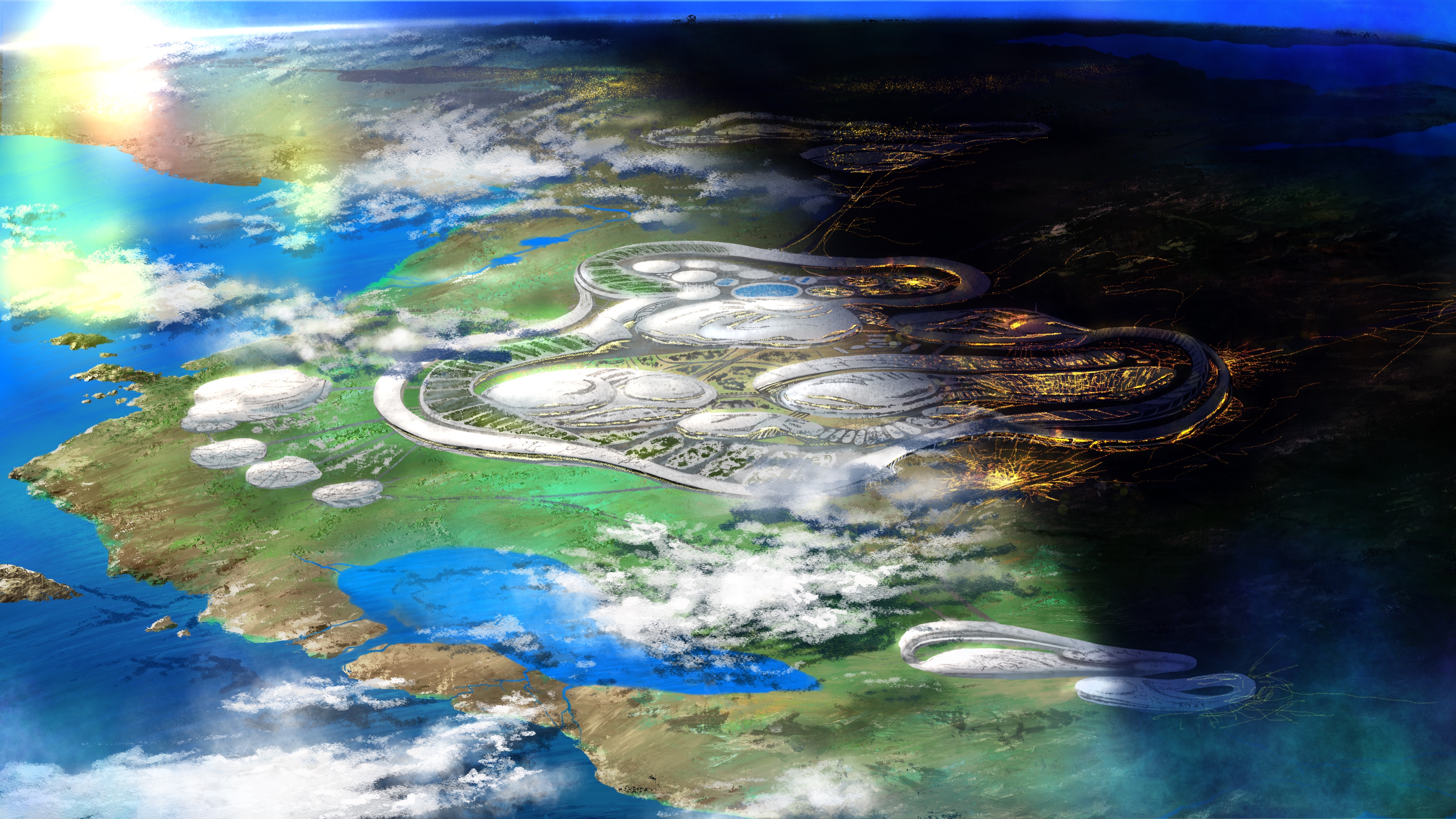
• Estimated to have been 10% of Earth’s surface.
• Land masses are like floating islands, each run by a different corporation.
• The layout of the inlands was usually an automated urban area in the center and the rest abandoned and neglected.
• Throughout the inlands, one could find remnants of the past, such as highways, factories, warehouses, among other public and private infrastructures.
• Each floating land was cradled by a large wall that was constructed to provide safety from deadly tsunamis. The Wall also served as a barricade against the illegal entry of the outlanders.
2. The Outlands
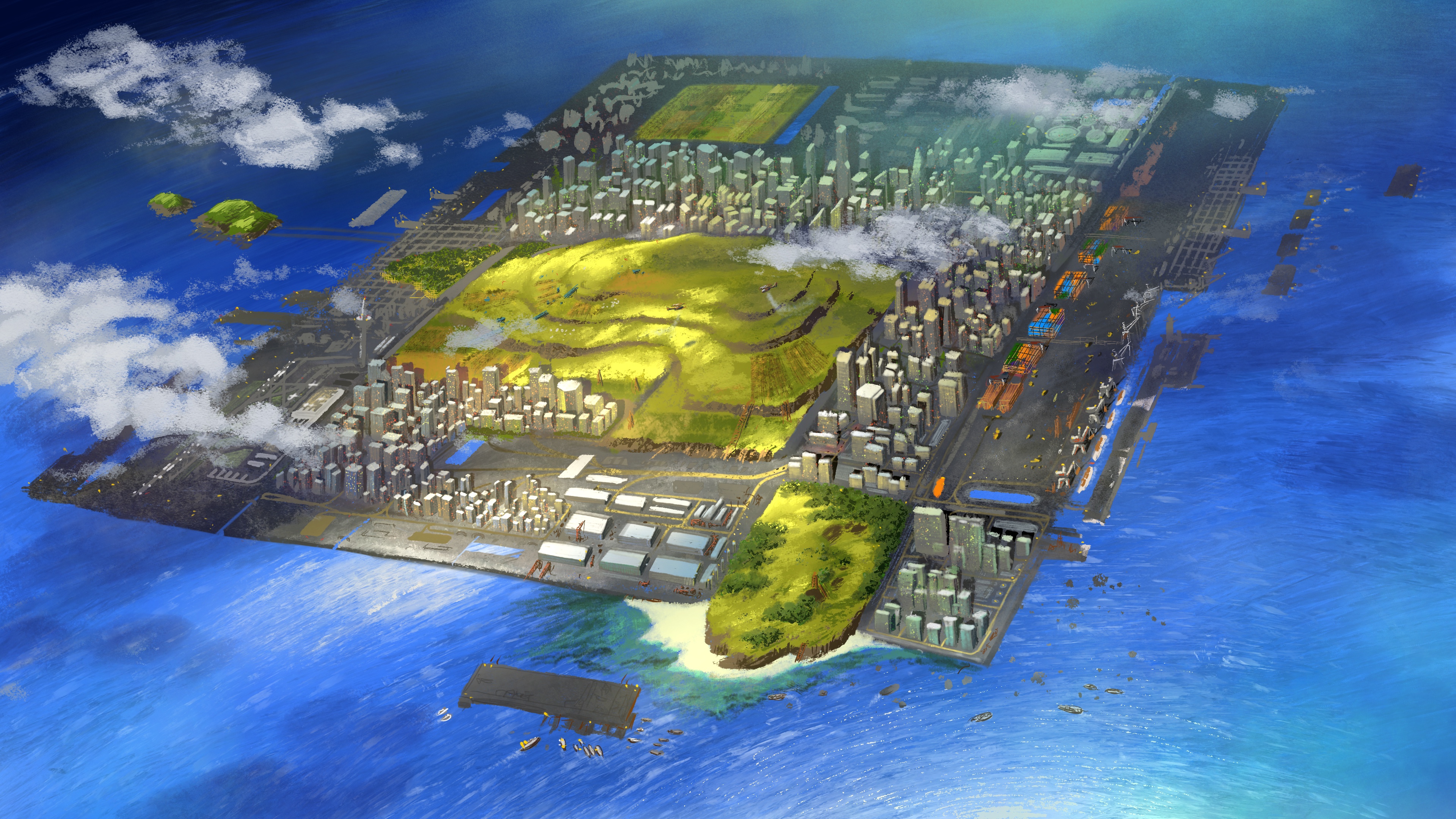
• Estimated to have been 90% of the Earth’s surface.
• Natural disasters, such as tsunamis and typhoons, became frequent.
• Floating trash islands were shared as multifunctional public spaces for the outlanders.
• Most people lived on houseboats built DIY; the typical houseboat is equipped with a self-floating generator in its exterior and residential utilities are crammed inside.
• Corporate-state operated toll gates were erect throughout the outlands.
The Metaverse
This was the only space the inlanders, outlanders, and midlanders could all equally access and interact with one another. 23rd century people received a surgical operation at birth to embed the Metaverse access device in the shape of an eye in one’s forehead. Soon after, children quickly became accustomed to accessing the Metaverse simply by closing their eyes.
The Metaverse was run by DAO operations. Engineered with a generative algorithm, the Metaverse was like a living garden that propagated according to the user activity in DAOs. The Metaverse was an ethereal sight in stark contrast to the fractured terrain of Earth.
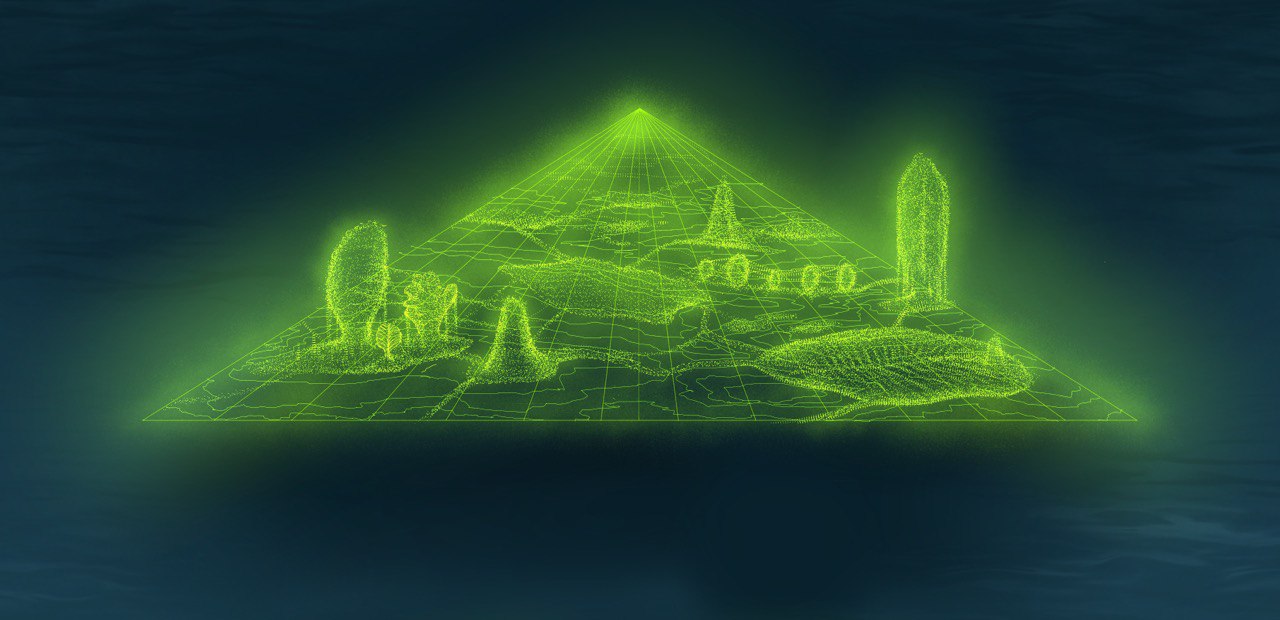
Origin
• No one knows who or when the Metaverse was designed. Such information remains undiscovered somewhere in the deep sea. There are many rumors and speculations but the mystery adds to the allure of the landscape.
Data formations
• The excavated data-fossil offers insight into the appearance of the Metaverse. It is believed to have resembled the Ediacaran biota. It seems profoundly symbolic that the auto-generated architectural structures of user data activity would have a similitude to the specific fauna forms of the late Neozoic era. Data formations of a DAO stratified over time and in the process, particular data sets would fossilize.
Additional facts…
• The spatial dimension of the Metaverse automatically warps when the user is in motion. This was especially useful for the outlanders who were restricted to the confines of a small houseboat. The warped space would be reconfigured and rendered first before appearing before the user so there was no discomfort.
• Everyone joins various DAOs and casts votes for proposals. Many of these votes are not necessarily casted by the users themselves. For menial proposals, using artificial intelligence technology, the user’s avatar would analyze past voting history and everyday data collections to make an informed vote on behalf of the user.
• The assets distributed among DAOs were not distinguished by the categorization (outlander, midlander, inlander) of the person. Though each DAO had their own unique voting system, some organizations strictly adhered to a monetary voting system, meaning the more assets a user would freeze in the DAO vault, the more political leverage that user would have within the organization.
• Metaverse archaeologists are committed to the research of 23rd century data-fossils, but it is still in its early stages.
RESOURCES
Even in the most dire situations when all seemed scarce and meager, there were some resources that were available in abundance. Here, we take a look at what the 23rd century people had to survive. For the outlanders, most of the valuable resources were scarce to them. Descriptors such as infrastructural support, health and work benefits, and sustainable quality should mostly be attributed to the lives of the inlanders who lived in the central cities.
Abundant Resources
1. Satellite Internet
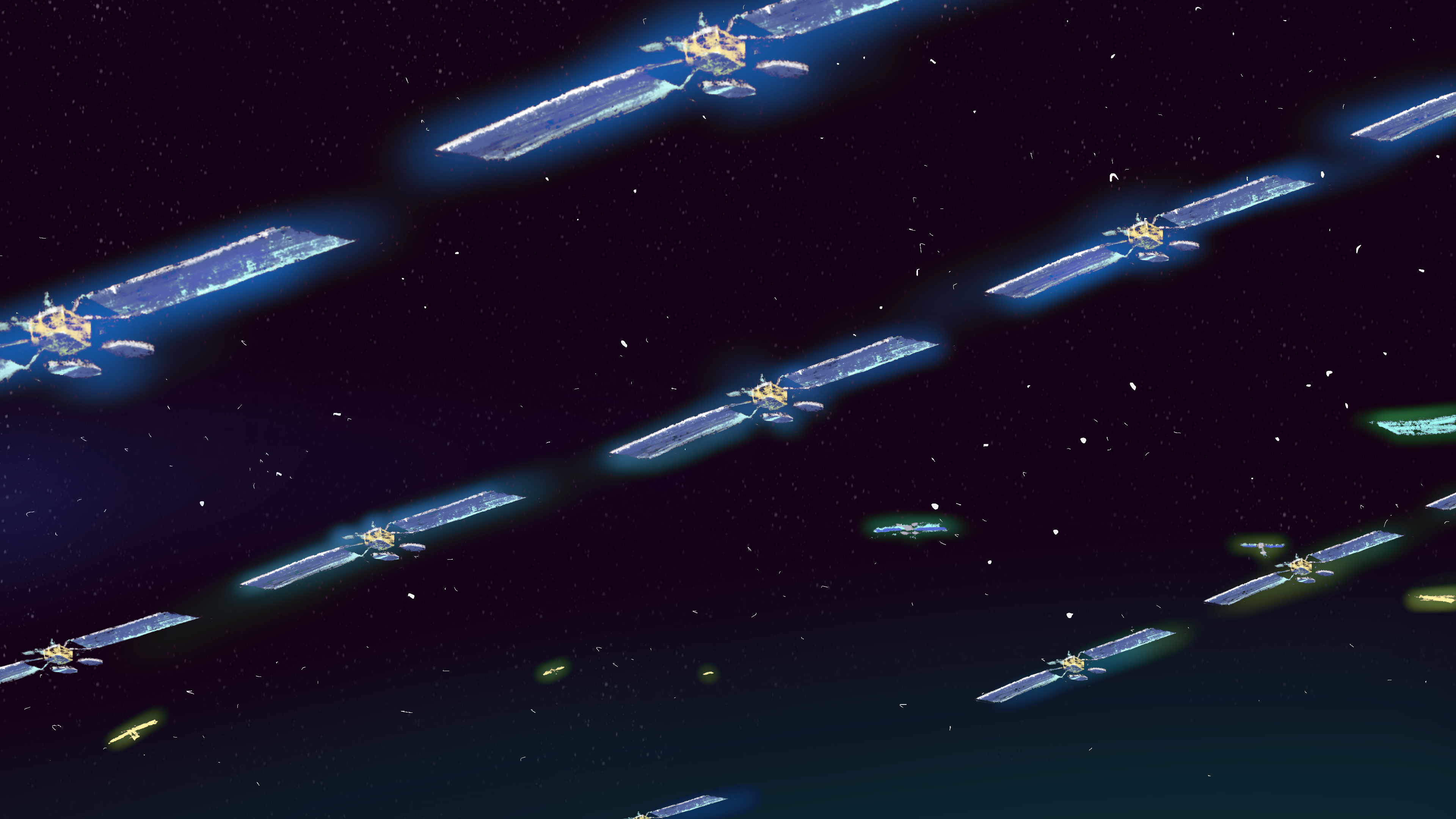
Launched long before the 23rd century, satellites provided plentiful Internet service to everyone. Satellites were arranged in a tight-knit grid layout, so much that they obscured the sight of stars in the night sky. Thanks to the smooth Internet connection, utilizing decentralized blockchain technology for the Metaverse was frictionless even out at sea.
2. Personal Data Server
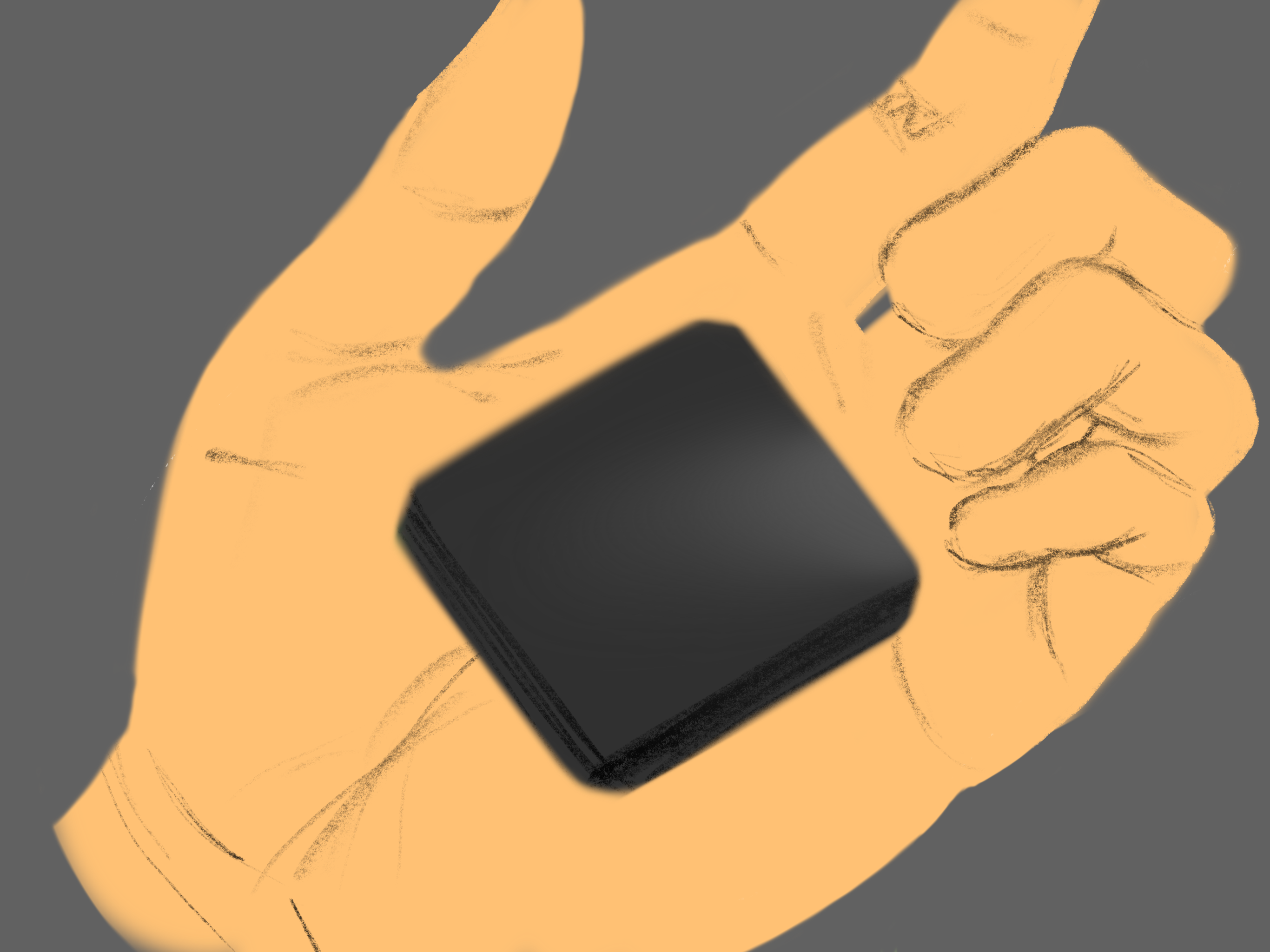
Despite its minuscule size, this data server stored years and years worth of personal data generated from numerous sensors and on the P2P network. The outlanders usually installed these servers directly into the houseboats and became one of the staple features of a houseboat.
3. Unstable Workforce
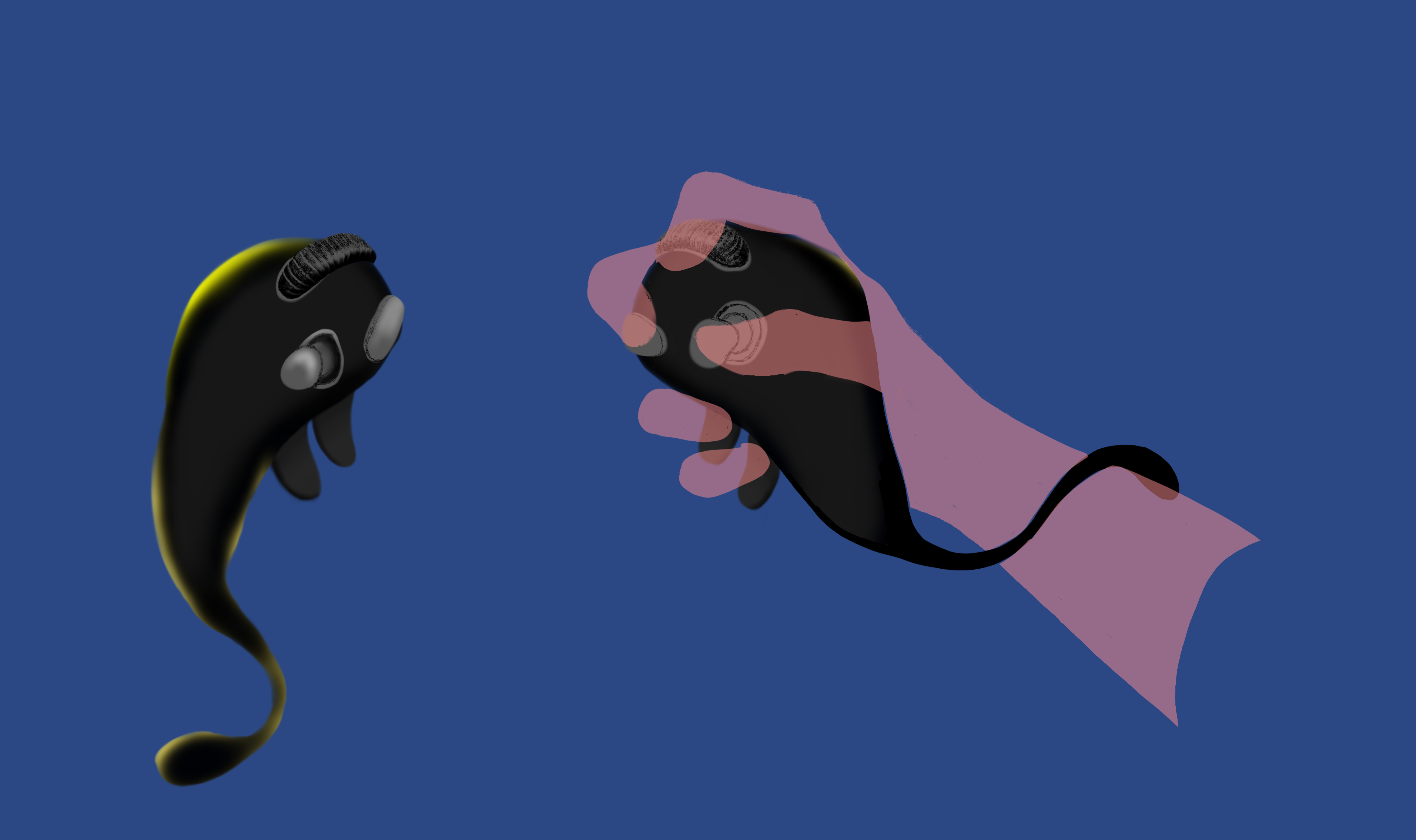
The inlanders offered many job opportunities to the outlanders, regardless of what the actual wage budget was. During the 23rd century, work took place on the Metaverse. The luxurious lifestyles of the inlanders were entirely maintained by the labor of the outlanders. Working remotely via the Metaverse meant the labor chain was distributed, and the outlanders would usually operate outdated machines and robots in factories. There were some outlanders who modified their physical bodies to better suit the features of their designated robot (ex. Attaching multiple arms).
4. Seawater
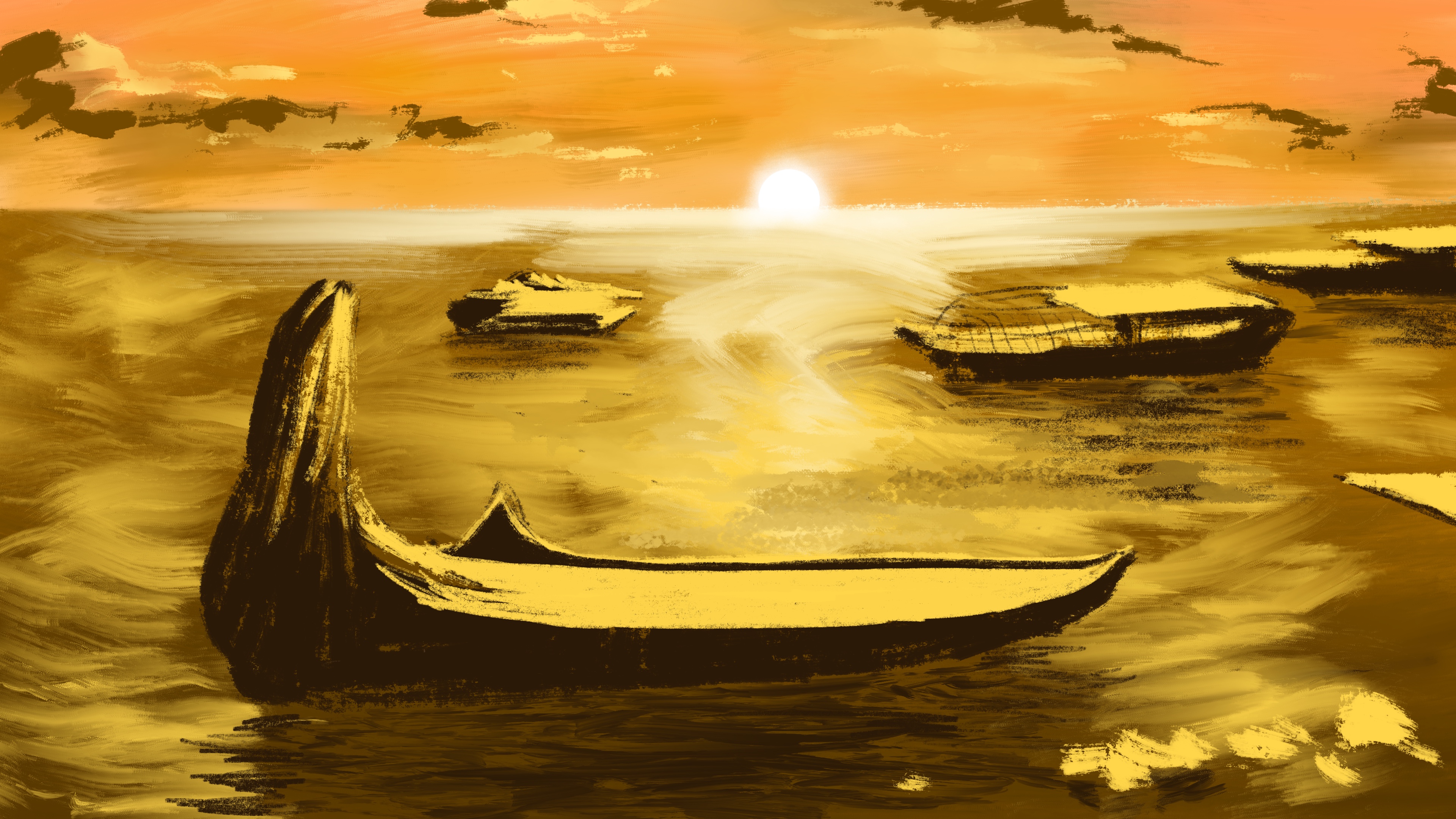
The sea level rapidly rose, and the wild oscillation of the ocean came to greatly affect everyday life. The outlanders built houseboats using floating wave generators to withstand the turbulent environmental conditions.
Scarce Resources
1. Energy
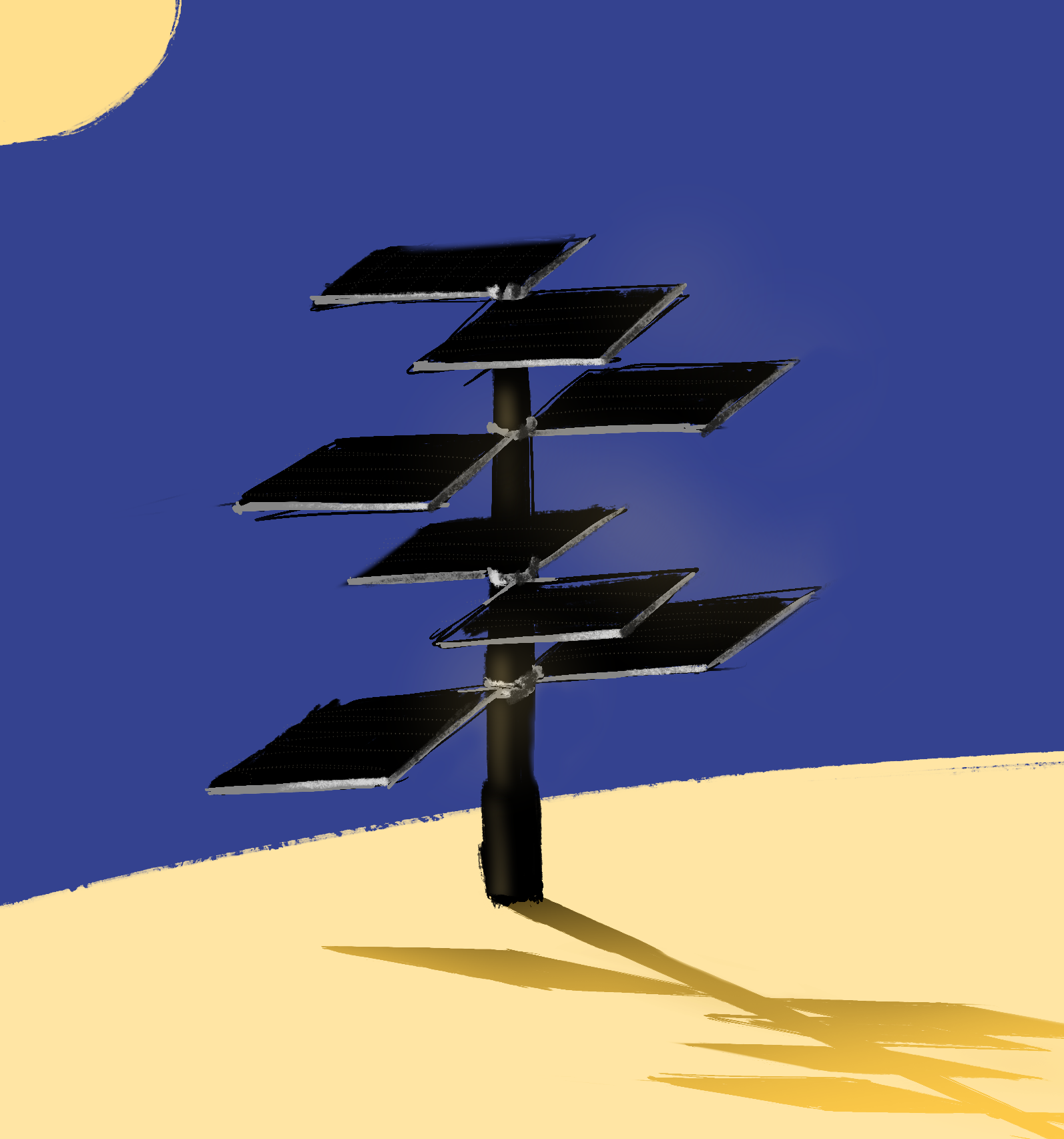
With the rise in sea level, not only was it difficult to generate energy in general, producing energy from fossil fuels was too cumbersome. Alternative renewable energy was the more viable option but it was difficult to generate enough in a timely manner. The houseboats of outlanders, for example, were equipped with wave, wind, and solar generators, but people would have to drop the anchor at a particular spot for several days to sufficiently recharge. There were many conflicts over the production and distribution of energy supplies.
2. Public Safety
Life outside of the inlands, law enforcement was established by a group of anarchistic DAOs. There was a vigilante DAO that performed the roles and responsibilities of the police, but for those who did not have assets in this DAO, the vigilantes may have as easily become robbers.
3. Infrastructure for Disaster Management
The outlanders are almost defenseless in the face of natural disasters. Infrastructure for disaster management stalled in preliminary stages for the outlanders. By today’s standards, infrastructure to respond to natural disasters seems to have been wholly insufficient for everyone during the 23rd century.
4. Land
Land (the inlands) are a privilege for the few. Access to the land was blocked off by a large barrier. Real estate ownership was one of the most prized assets of the inlanders. “Land” formations could be spotted floating in the outlands. These formations in reality were trash islands or barges linked together. Trash islands were naturally formed as construction waste, plastic, and other human waste accumulated with the current. These land masses served as public spaces for the outlanders to share for temporary residence, meeting spots, and other public events.
5. Medical service
There were no proper hospitals or medical services in the outlands, making people vulnerable to uncountable types of diseases and accidents. Trans-humans, the outlanders and midlanders who had modified a significant amount of their physical body as machines, were in particular targets of incurable diseases and malfunctions. There were a few AI surgical machines but most outlanders relied on pharmaceutical drugs traded on the black market. As the manufacturing of drugs did not undergo any verification process, it was not uncommon to find non-drugs sold as drugs on the market.
HUMANS
There are no definitive ways of grouping the population of the 23rd century. The usual race, gender, ethnic-based criteria was not applicable during this time when nation-states had dissipated and people were greatly separated from one another. Metaverse archaeologists have, however, found similarities amongst people based on their geographical location and have found it useful in their research to group them into three primary categories: outlanders, inlanders, and midlanders. Some research reports also include the term ‘Hinterlandian,’ speaking to all who lived in the 23rd century. Though a convenient term, ‘Hinterlandian’ may be misleading as people were not equally subject to the living conditions of the general understanding of the hinterlands.
It is important to remember that the categories are only used for research purposes and are not official terminologies nor classifications. Also keep in mind that most of the information extracted from the fossilized data is in regards to the outlanders. We can speculate that the outlanders depended the most on the virtual infrastructure of the Metaverse leaving much permanent data on various DAO blockchains that eventually stratified with key information left for us to seek in the form of data-fossils. This among many others are peculiarities particular to the time that require more study.
• Hinterlandians all embedded a device used to access the Metaverse called the ‘Metaverse Eye'.
• The outlanders accessed the outlands and the Metaverse.
• The inlanders accessed the inlands and the Metaverse.
• The midlanders, the lowest class of the inlands, were the only ones who could traverse both the inlands and the outlands, performing their assigned duties.
The Outlanders
Simply put, the outlanders were stateless sea nomads. Born at sea, they adapted to the undulating waves, so much that they felt vertigo on stable ground. They augmented parts of their physical bodies for the harsh environmental and living conditions and for virtual work in the Metaverse. The outlanders spoke different languages. It is believed they had real-time in-ear translators or used some kind of common language. Their wealth was distributed among multiple DAOs. The reality of basic life support such as food security, boat repair, public safety, entertainment, job security, and more were thoroughly implicated with the proposal and voting system of DAOs.
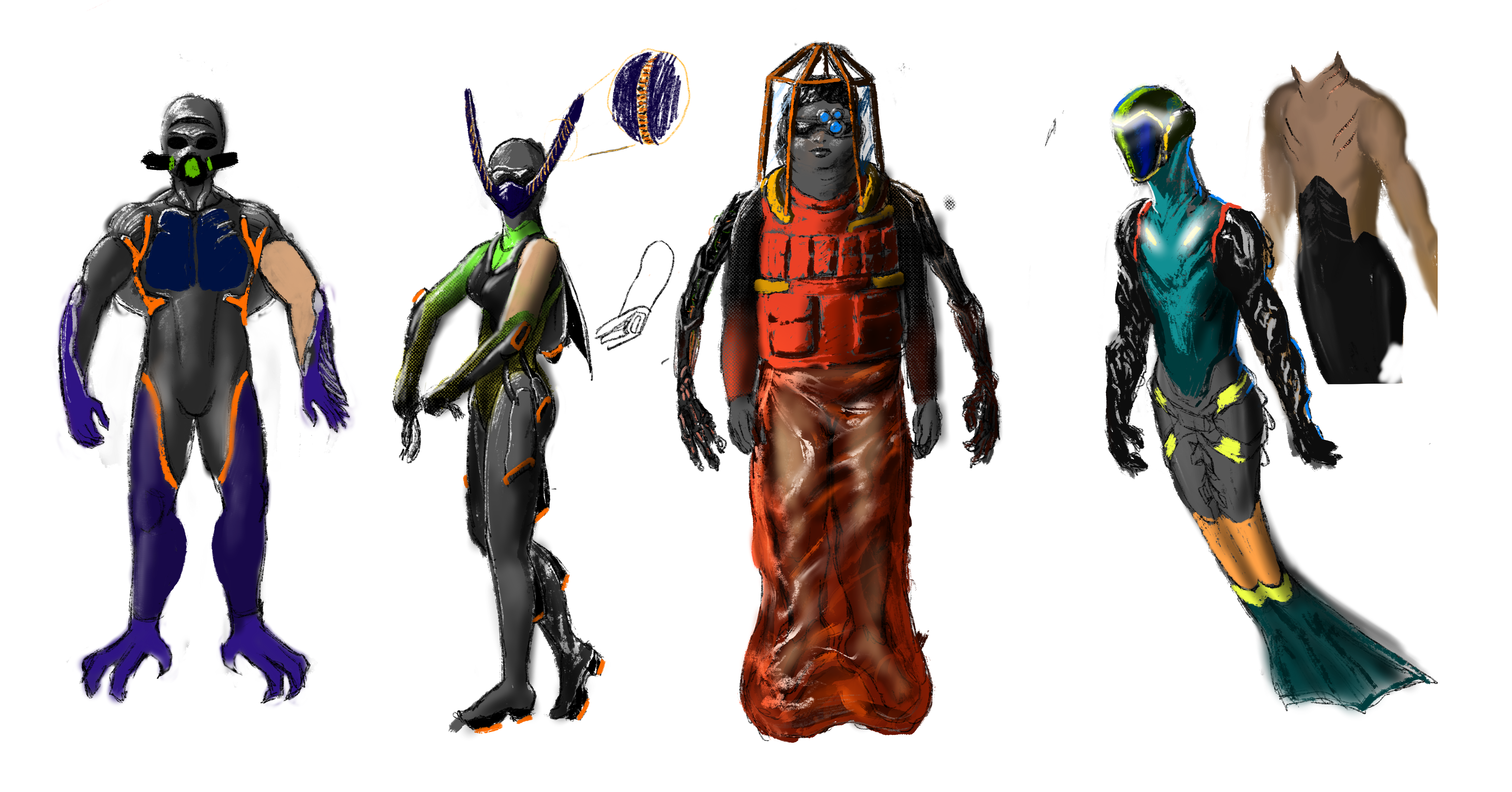
The Inlanders
The inlanders were part of corporate-states that took hold of the infrastructure of the former nation-states. These are people who lead a good quality of life. They had a fashion culture of wearing translucent clothing; they basically walked around in complete nude, which goes to show that they were proudly pure humans who did not require body modifications for the purposes of everyday survival. Such culture can also be taken as evidence of high quality professional medical services. Though these people used mobility assistance devices and could walk with little to no effort, they generally maintained a strong, healthy body through sports activities and balanced nutritional diets. Researchers have not been able to find much data on the inlanders nor what the central cities of the inlands looked like. Arbitrary information on their dress code and general physical characteristics were largely sifted from the inlanders’ activities on the Romance DAO, a DAO which unknowingly cultivated widespread social engagement and connection among the outlanders, inlanders and midlanders.
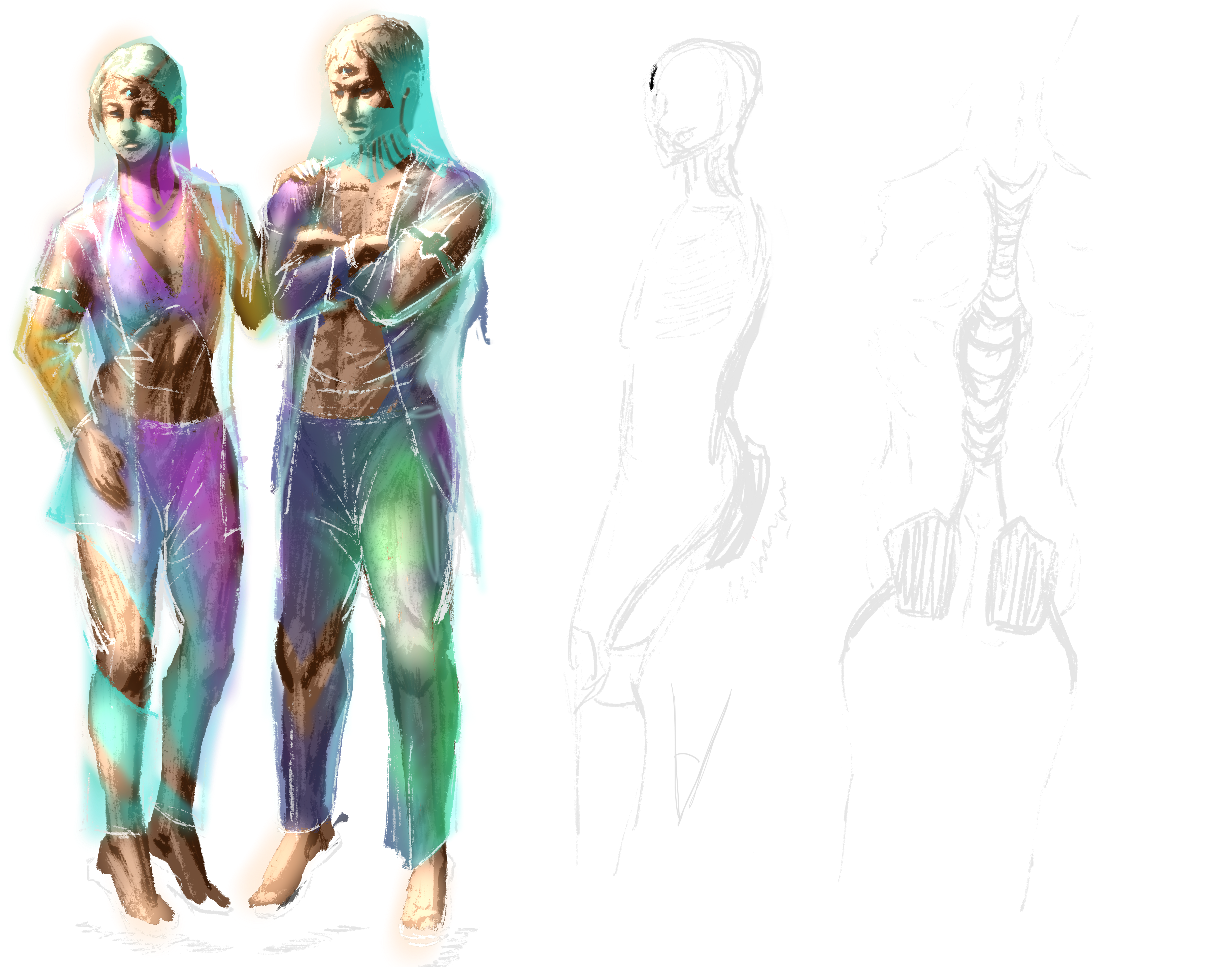
The Midlanders
Those born to the lowest class in the inlands. They usually worked in warehouses and undertook labor that traverses between the inlands and the outlands; they dumped waste in the outlands and extracted resources from the sea. As these people did not have the financial capacity to live in the automated city centers, from an early age, they led life on the outskirts of the city. They usually occupied the ruins of bygone cities, wastelands, and abandoned factory warehouses.
Despite the ability to enter the central city, they only had access to the lowest quality of medical services and public infrastructure. Their living conditions were so poor that the midlanders modified their bodies to the extent that they appeared to be a machine with some human qualities, rather than the other way around like the outlanders. It appears they had a particular fashion culture of favoring transparent plastic coverings for the areas that were modified so that others could see the well-functioning mechanics of the machine parts. Perhaps a way of showing off? Such stylistic preferences made it possible to easily distinguish between the outlanders and the midlanders, even though they both have modified bodies.
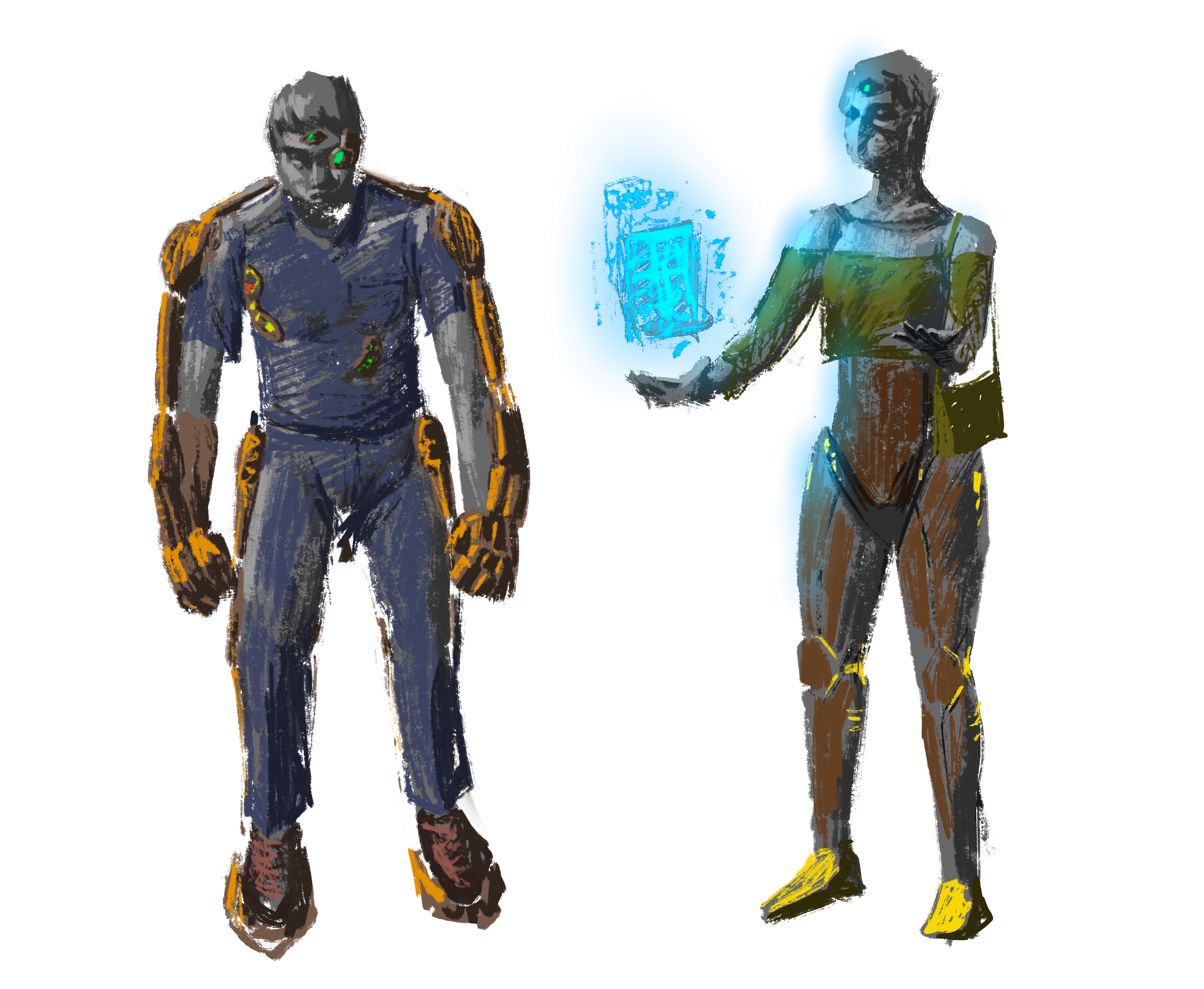
TRANSPORTATION & HOUSING
Excluding the Metaverse, the inlands and the outlands were thoroughly segregated spaces. Unfortunately, the excavated data suggest little on life on the inlands. Depending on the geography, each group of people adopted a distinct form of transportation and housing.
• The boundaries of life on the inlands and the outlands are thoroughly separated, with the exception of the Metaverse.
• Out at sea, transportation and housing security was achieved with houseboats.
• There were also “public” spaces or shared spaces that took advantage of floating artificial trash islands and barges.
• There is no data to suggest what facilities or lifestyle the inlands consisted of. Or, the information remains as confidential data and is yet to be decrypted.
The Outlands
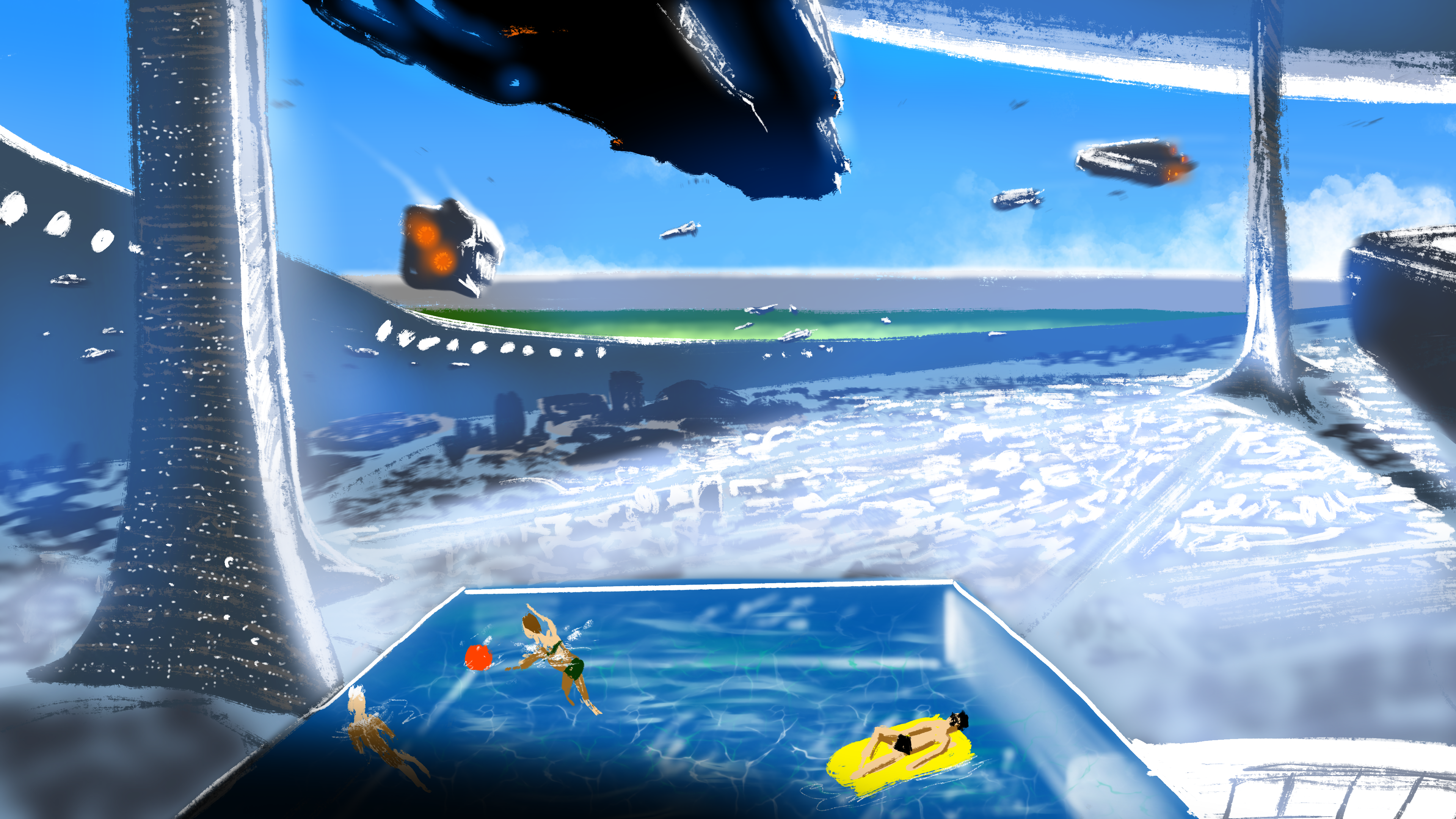
Our understanding of the lifestyle and culture of life at sea comes from a detailed observation of houseboats and artificial trash islands. All outlanders lived on houseboats, and the construction of trash islands was akin to creating public spaces for them.
1. Houseboats
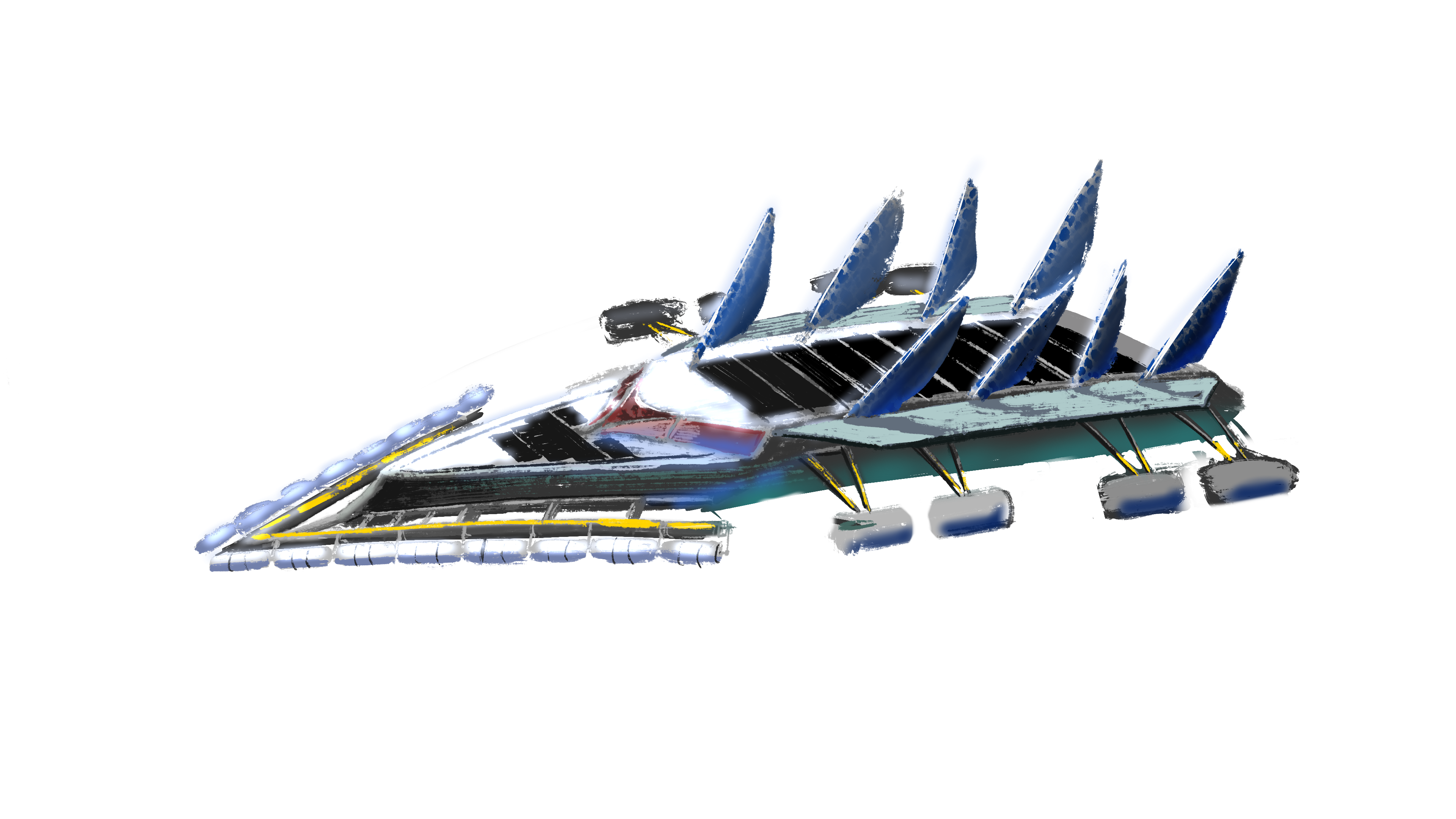
• Autopilot mode available
• Functions as a form of transportation and residence.
• Possible to connect with other boats. Parties and events would be hosted by chaining multiple boats together.
• Equipped with a personal data server.
• The structure was akin to a boat installed on top of a floating renewable energy generator.
Houseboats were an essential survival mechanism as sea level was rapidly rising. They looked like a generator attached to a ship or a ship attached to a generator. To be born in the 23rd century outside of the inlands meant in one way or another you would own a houseboat. People were able to eat, sleep, play, work, and pretty much do anything on these boats.
2. Artificial Trash Islands
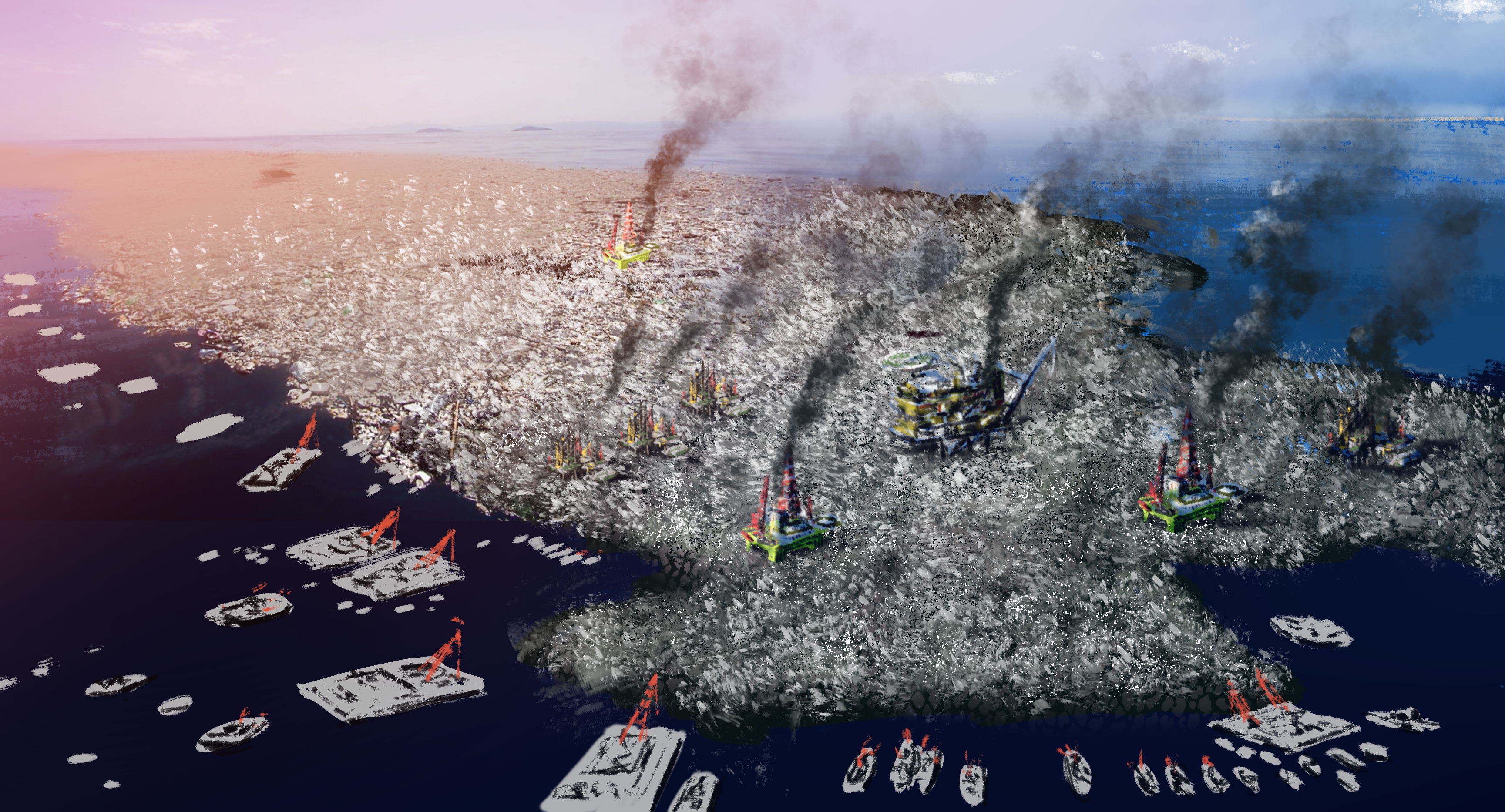
• Waste from both the inlanders and outlanders that naturally accumulated to form a floating landmass in the ocean.
• Technology was developed to direct waste to form trash islands more efficiently.
Artificial trash islands were an accumulation of construction waste, residual plastic and anything hard and sturdy. They functioned as a public space and temporary land base for the outlanders. There were storage structures and clearings for physical meeting areas that certain DAOs built on older islands. Other uses included boat recharging stations, infrastructure for simple medical and educational services, and even black markets. Knowledge acquired on these trash islands were not much different from that of the inlands and, at times, would be more practical.
The Inlands
From the meager data available on the inlands, we were able to conjecture on its urban planning. Besides the central automated city, much of the inlands remained desolate. Within those peripheral areas, the only structure newly built in the 23rd century was ‘the Wall.’
1. The Wall

• Spearheaded by the inlanders, the Wall was built to block the illegal entry of the outlanders, and as a preventative measure against further rise in sea level and destructive tsunamis.
• The effective design of the Wall would disperse crashing waves and expel excess water and/or waste from the central city.
• The Wall was so large that even from the highest point of the city, one would not be able to see the ocean. The outlanders out at sea could see the Wall from everywhere and were not able to even begin to imagine what life beyond the Wall looked like.
• The seemingly endless wall completely prevented entry points for the outlanders and illegal exits of any inlander.
2. The Smart City
• The smart city was almost completely automated and homogeneous. The city was designed to be safe against most natural disasters, and very few inlanders understood or cared about how the city was maintained.
• Only a few inlanders had the privilege to reside here, and there was absolutely no way to live in the central city unless one was born into the ultra-upper class.
3. Ghost Factories
• Corporations replaced the role of countries, and they owned factories and facilities located in the outskirts of the central city.
• The outlanders entered the Metaverse and used various devices (ex. controllers and joysticks) that were virtually connected to outdated robots inside the inland factories. Their range of vision was restricted to what the small sensors of robots reflected onto their screens. All other intermediary labor and on-site management were performed by the midlanders.
• The term ‘ghost factories’ was specifically divulged from the outlanders’ and midlanders’ records on the excavated data server. Though it is not known when or who first used this term, ‘ghost factories’ seem to aptly describe the conditions of the worksite as the head operators of the factories would have been virtually unknown to its workers. It is also a term befitting to describe the fragmented and disorienting image of the factory that would have appeared to the laborers.
4. Warehouses
• These were spaces occupied by the midlanders who were primarily responsible for overseeing the import and export of cargo between the inlands and the outlands.
• The warehouse buildings were neglected and abandoned spaces that were built by the older civilization, outside of the interest of the inlanders.
• The eerie atmosphere of the warehouses combined with the half-machine midlanders create a gruesome image.
ESSENTIAL DAOs
The Metaverse was held together by the network of various DAOs. As trading and transactions between DAOs were not standardized, each DAO could be seen as an individual endeavor. Nevertheless, wealth and users crossed over multiple DAOs, and most of our knowledge on the 23rd century stems from the data of DAOs.
• Each DAO was separate but users were able to take assets out of one vault and transfer it to another, allowing them to partake in multiple organizations simultaneously. In order words, DAOs in the 23rd century were independent but established a symbiotic relationship.
• Each DAO had their own voting system. There were cases where casting votes required money.
• Most of the votes were casted by artificial intelligence on behalf of its user. The voting algorithm was representative of the cumulation of data on the user’s daily life, previous voting records, and other activities on the Metaverse. For very important agendas, users casted their own votes, but this was rare.
1. Agriculture and Livestock DAO

• This DAO was brought about to secure food supply.
• Its members were mostly the outlanders, and the DAO owned physical bases at sea such as the artificial trash islands.
• Compared to other DAOs, conflicts within this DAO were mediated in a civil manner.
• There were rumors that most of the raw materials for narcotic hallucinogens, distributed in the inlands, were produced by this DAO due to the fact that there was no authoritative monitoring in spaces beyond the inlands’ smart cities.
2. Storage DAO

• This DAO was predominantly operated to fulfill the needs of the outlanders and had physical bases throughout the ocean.
• Its sole purpose was to compensate for the limited surface area of a houseboat.
• Its operating mechanism was the most intuitive: the size of the storage space was commensurate with the amount of assets deposited into the Storage DAO vault.
3. Mechanic DAO

• The Mechanic DAO provided services crucial for the outlanders, such as repairing energy generators and houseboats.
• Its members included mechanics who specialized in the repair, maintenance, and assembly of machines, as well as scientists and engineers.
• An unexpected amount of assets were concentrated in this DAO. The reason for this can be deduced to the fact that there were no other organizations that dealt with machine manufacturing and led mechanics-related research.
4. Entertainment DAO

• There was a DAO for the (idol) entertainment industry in the metaverse, and was commonly referred to as the Enter DAO.
• It is known that there was a physical base called a 'dormitory' on the outskirts of the inlands, but the specific location and operation were kept under a confidential DAO contract and there is currently no data available to validate the existence and specific operations of such dormitory.
• Proposals and votes related to the competition show business, mainly in the form of auditions, were popular.
• There is nothing known about the personal history of the idols who were active in the Enter DAO. Based on the unearthed data alone, information on family and human relationships are surprisingly vague. This has led some to believe that the Enter DAO worked solely with orphans and missing people.
5. Religion DAO

• This DAO was at the center of people sharing and fulfilling the mysteries, beliefs, and faith of the 23rd century.
• The mystery of the creation and operation of the Metaverse became the seed that spawned various campaigns of the Religion DAO.
• To raise equity initially, it is believed that the DAO adopted a polytheistic front to attract both the outlanders and the inlanders. Since then, the number of gods that were worshiped drastically decreased.
• They practiced unusual religious customs, for example, salt took up an excessively large role in prayer rituals. This is probably because a significant number of outlanders joined the DAO in its early days.
6. Education DAO
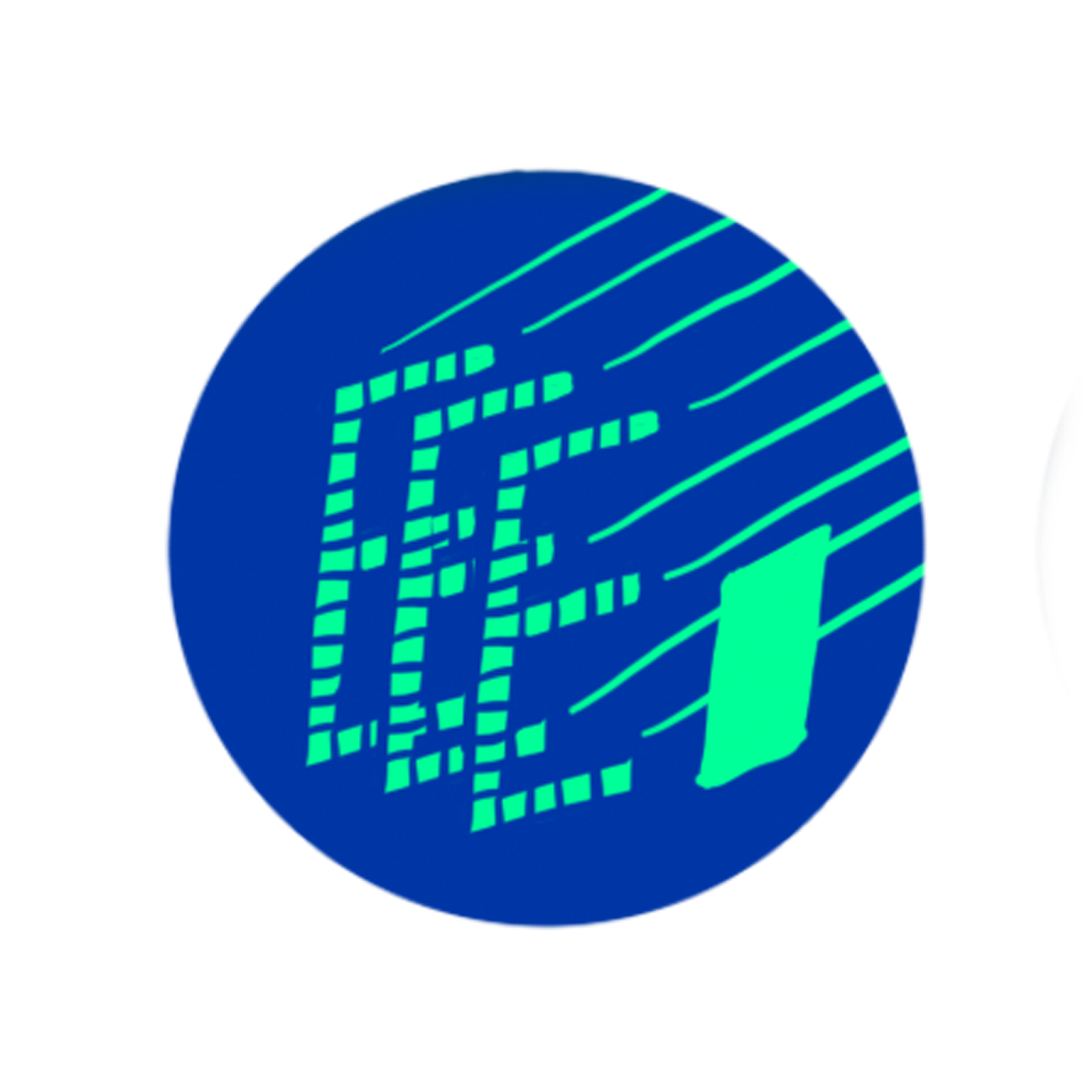
• Membership to the Education DAO (or, simply Edu DAO) was strictly recommendation-based and could not be joined voluntarily, and the recommendation had to come from an existing member of the Education DAO.
• Recommendations for new members were first presented as a proposal and other members proceeded to cast votes on their approval of the candidate. During the evaluation process, prospective members introduced themselves and engaged in various activities that would help convince the members.
• Should a member cause trouble and get expelled from the organization, the asset of both the expelled member and the recommender of the member in the DAO vault would become commonly owned.
• The Edu DAO offered curricula of various topics, but the life skills classes were most popular for its practical applicability. In the marine life skills section, for example, subscribers attained critical knowledge on marine life and first aid..
7. Medical Care DAO
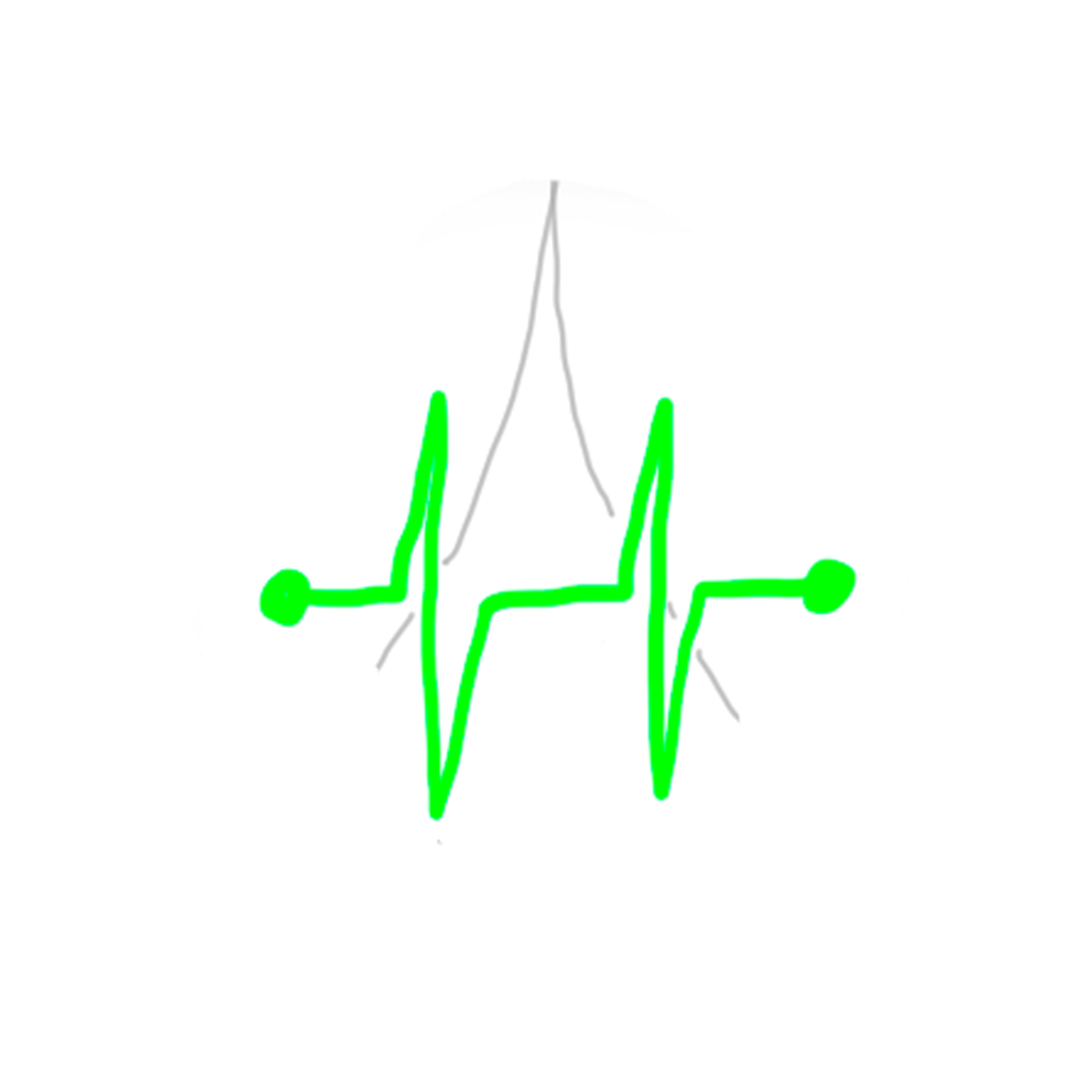
• A DAO for medical services.
• The medical and counseling services including diagnosis and treatment were often conducted remotely.
• As human life was constantly at risk in the 23rd century, its asset growth portfolio was quite impressive.
8. Romance DAO

• This was an astonishing organization that was able to bring together the inlanders and outlanders who were completely separated by the Wall.
• The main function of the Romance DAO was the mediation of anonymous dating on the Metaverse. Subscribers would seldom disclose personal information and meet in the physical world.
• Becoming a member of the Romance DAO had multiple stages. The first stage was emoji voting: existing members would review the candidates and cast one vote, or one arrow emoticon, each. The candidate who reaches the vote count during the set voting period were able to move onto the next stage.
• It was thanks to the data left by this DAO that we were able to conjecture the physical appearance and clothing of the three types of humans; it was one of the primary sources of information on the inlanders.
9. Court DAO
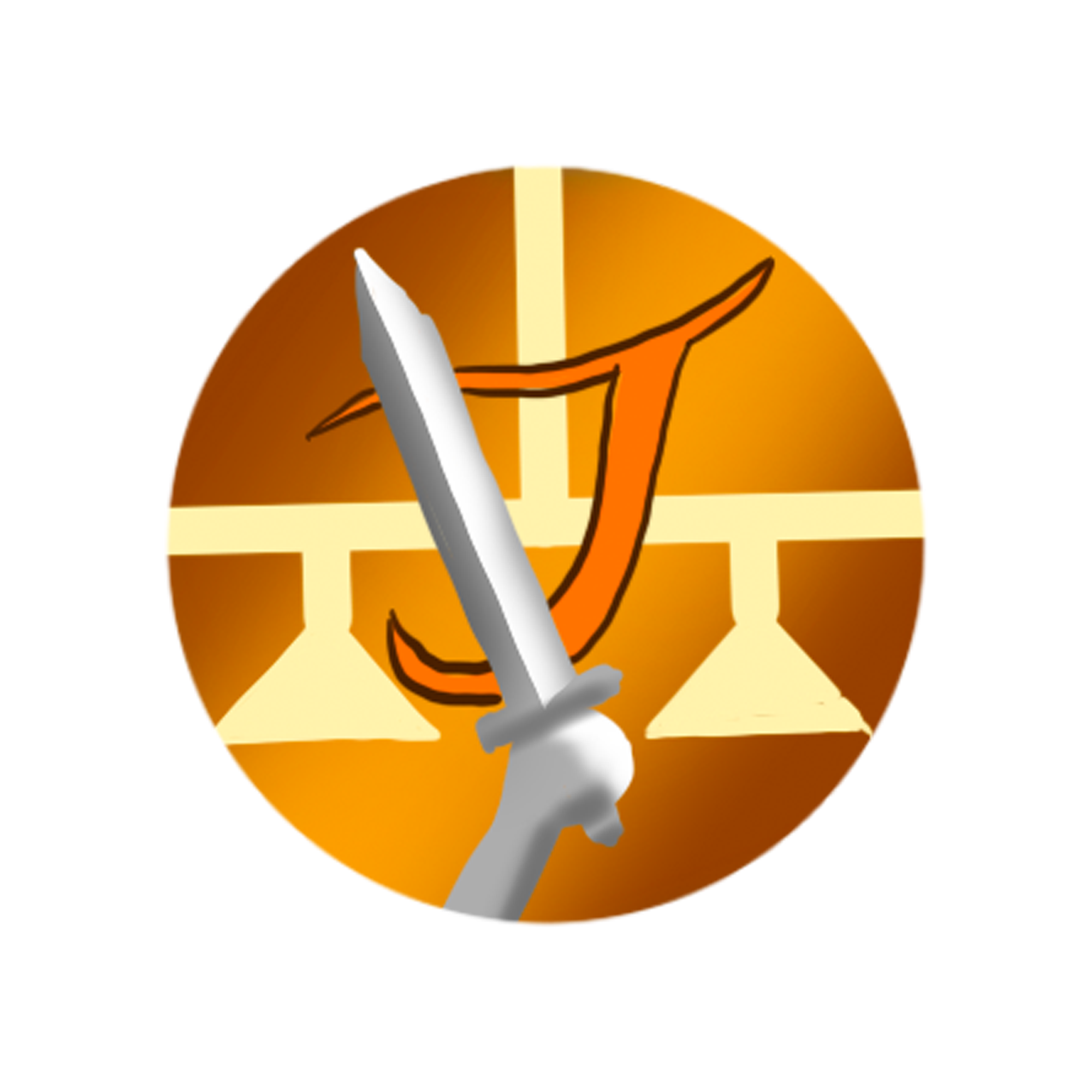
• This DAO served as the judiciary among people living in territories other than corporate-states’ automated cities.
• It was difficult to see the Court DAO as a fair operation as the organization’s asset growth directly correlated with its voting system.
• It is presumed that the amount of assets frozen in the vault had a significant impact on the wide-spread influence of the network.
10. Other DAOs
• There were other countless types of DAOs. For the reasons listed below, some of the DAOs were not detailed in this Sourcebook.
• Organized for a temporary purpose and disappeared.
• Merged with a larger DAO.
• Created and operated restrictively for private purposes.
• Provided services and functions similar to the DAOs listed above but were significantly smaller in scale.
• Served purely venturistic purposes.
CURRENCY
Many types of cryptocurrencies were excavated, and each currency had its own community. Below are four of the most common digital currencies that were used in the 23rd century.
• Exchanging a currency would have been equivalent to transferring the community you are part of.
• The inlanders commonly used DkRW, USDZ and other currencies distributed by corporate-states.
1. DkRW

• Presumed to be the crypto version of KRW, the 21st century currency for the Republic of Korea.
2. USDZ

• There is insufficient data to know for certain if USDZ started as a stablecoin of USD (the bygone currency of the United States of America), or if it is an integrated version of the SDZ which also existed in the past.
3. VBTC

• Hard fork of the BTC currency. VTBC was favored by the outlanders.
4. FETH
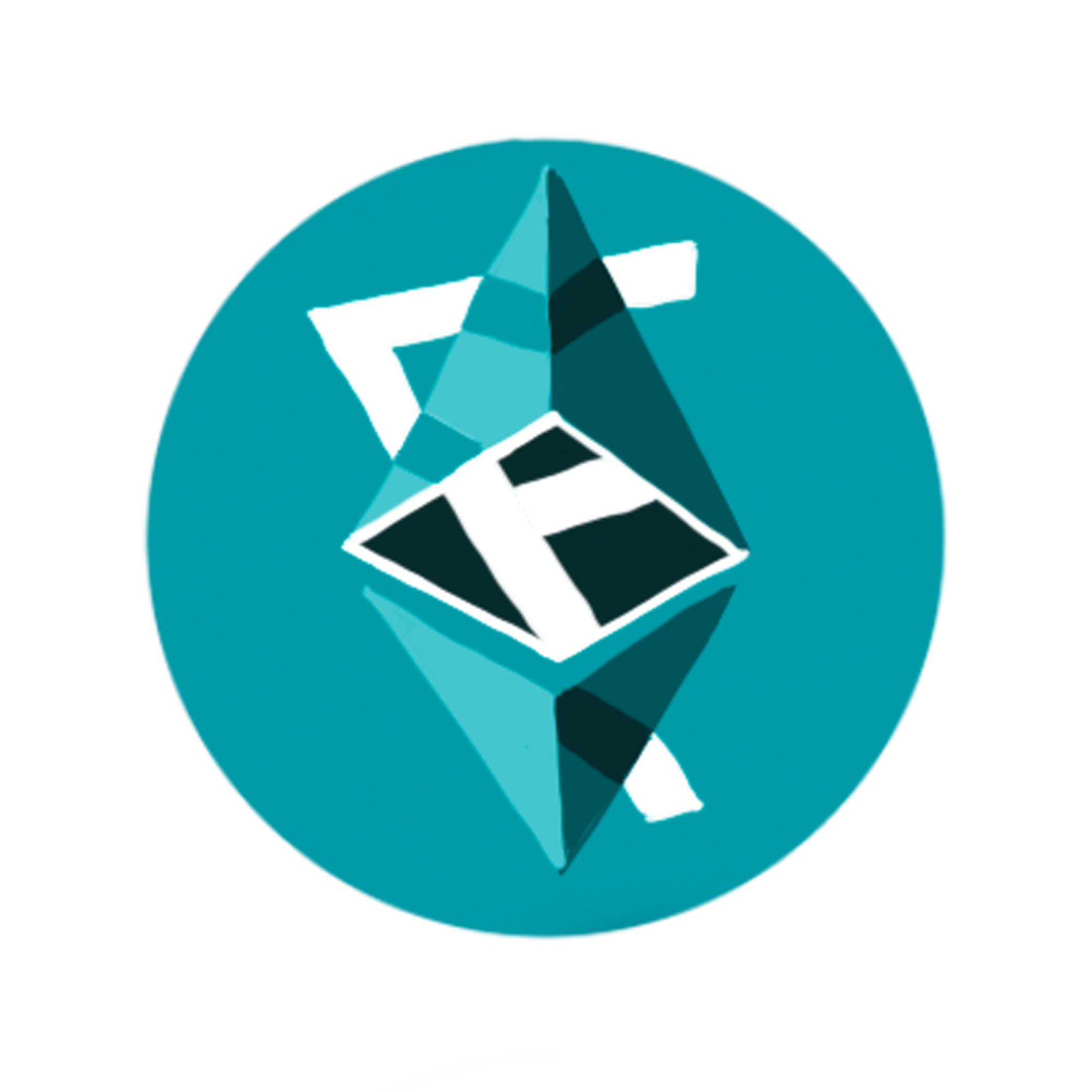
• The assets of almost all DAOs are converted to FETH to be stored in their respective vaults.
ESSENTIAL DEVICES

Below is a list of devices that were found in the data-fossil. Each device presents a unique characteristic of life in the 23rd century.
1. The Metaverse Eye

• Everyone in the 23rd century underwent a simple surgical operation at birth to embed a device to access the Metaverse in their foreheads. The device was referred to as the ‘Metaverse Eye’ as it resembled a human eye. Its main function was to facilitate access to the Metaverse and to show the access status of its user.
• When the user closes their eyes, the Metaverse Eye opens, visually showing its user’s access onto the Metaverse.
• Even if the user had their eyes closed, they were able to detect their surroundings. Take for example when the user’s body approaches an obstacle, the view of the Metaverse turns translucent for the user so that they can also see their physical surroundings.
• Users were able to record and share their view of the Metaverse in real-time.
2. Entertainment Console

• The entertainment console was primarily used as a hologram projector and a speaker. The console was devised to console the feeling of isolation that arises from continuously living in a restricted space.
• Its design resembles a large-scale bacteriophage. It had a function where the “legs” of the cephalopods would move in rhythm with the music.
3. Plant Cultivators
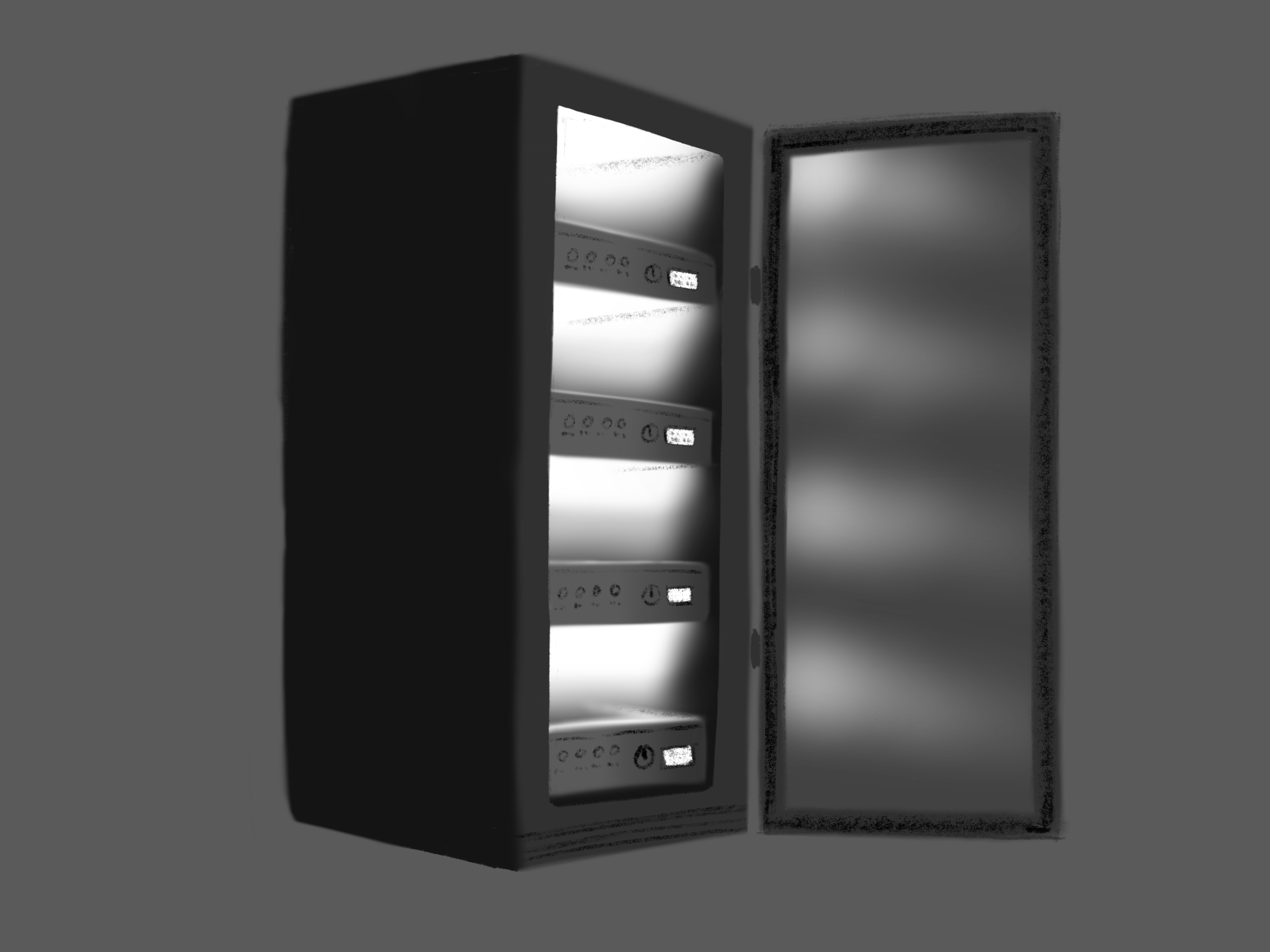
• Appliances used to cultivate plants that could be found in every houseboat.
• Its main functions were temperature, humidity, and lighting control; and as it also had the ability to desalinate seawater it could be used as a water purifier.
• The Livestock DAO managed the manufacturing and distribution of this appliance, and only DAO members who passed the user authentication process were eligible to possess it.
• Oftentimes, houseboats were chained together to host a farmers’ market where outlanders would sell and exchange their plants.
4. Dashboard
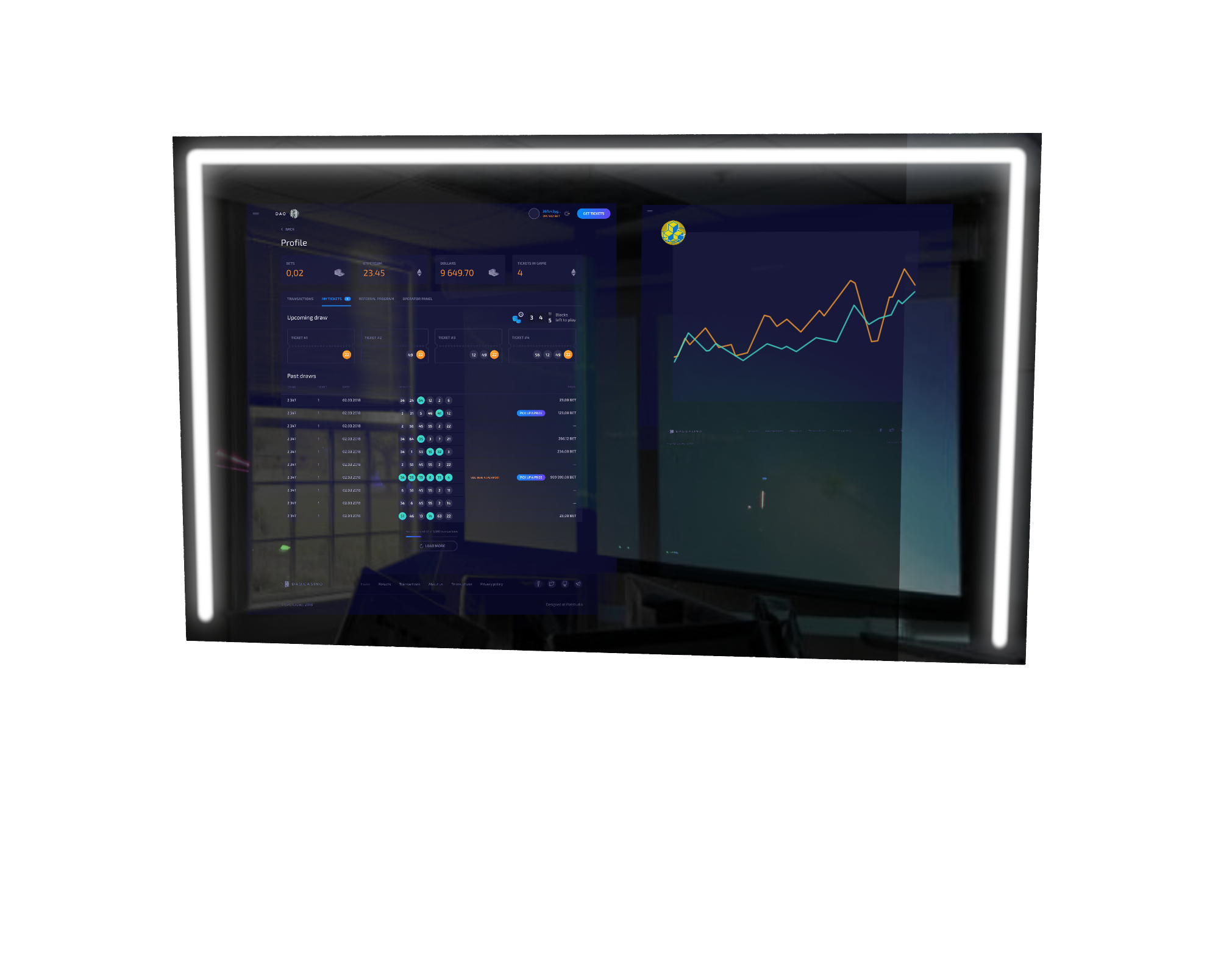
• Both a digital display screen and a wall mirror, the dashboard was an essential equipment for the outlanders.
• The dashboard was utilized for a variety of purposes including asset management, DAO proposal and voting management, chats and video calls, virtual classes and more.
• When not in use, the dashboard could be switched to the mirror mode, but most users preferred to keep track of the voting status for DAO proposals in real-time.
5. Personal Generator
• A core feature of houseboats that used waves, wind and solar power to generate eco-friendly energy.
• The production of renewable energy at sea was an essential business since it was an issue of life and death for the outlanders.
• The outlanders were ridden with anxiety when strong winds blew while simultaneously relieved that they would be able to save enough energy.
• The mechanical form of the generators varied considerably from boat to boat.
• Repair records were trackable on the Mechanic DAO blockchain.
6. Devices for the Metaverse Workforce
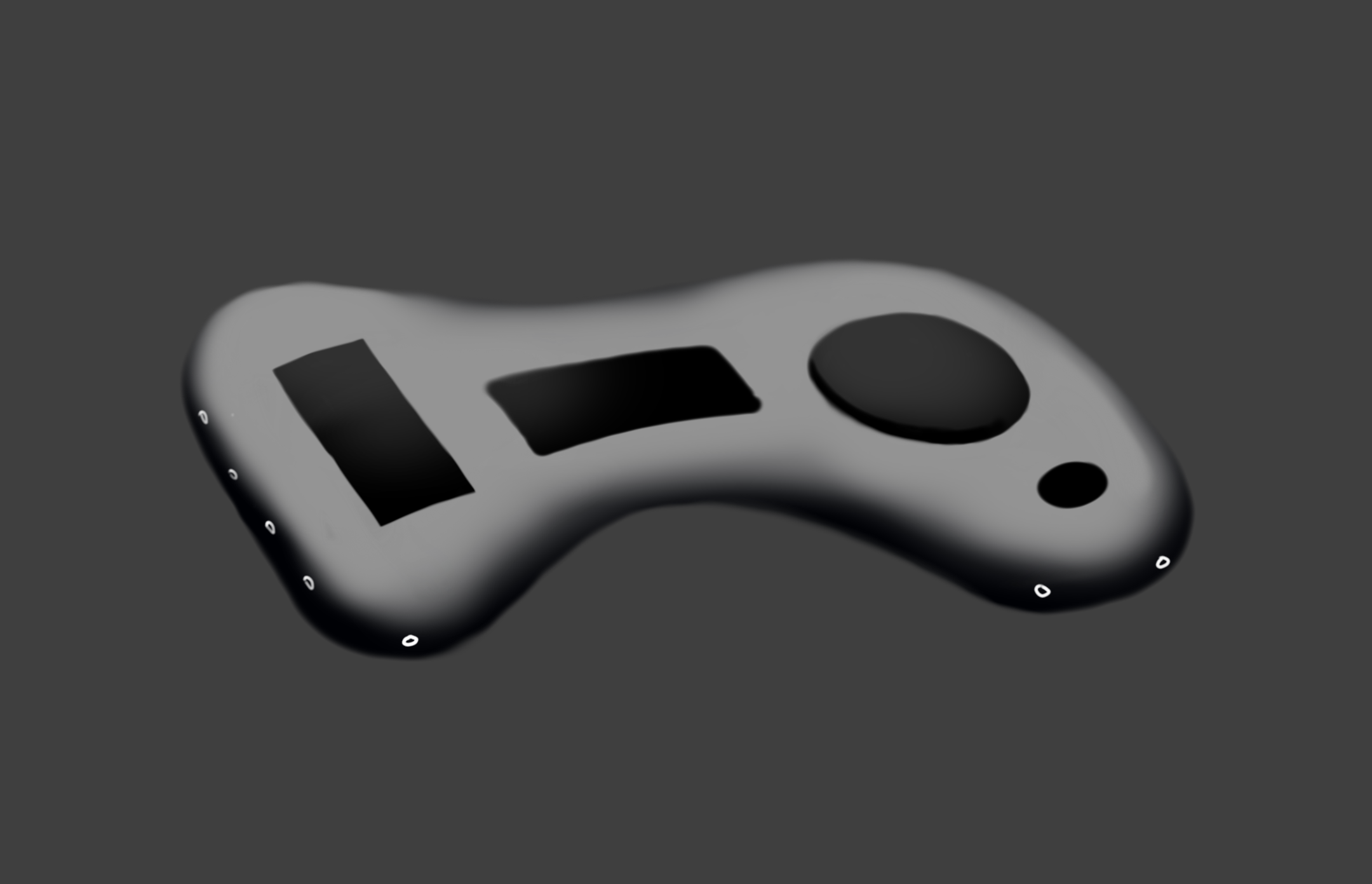
• For the outlanders, working via the Metaverse meant to remotely access the body of a robot within the smart factory. The experience of accessing and operating robots was an awkward experience as these robots were built in the past without such a situation in mind. The view from the robot was very limited, or some people navigated with the sole guidance of sound.
• Devices were developed to reconcile the difference in physical capabilities between humans and robots. Additional devices were devised specialized to a particular task.
• The device looked like a combination of a game pad and prosthesis.
• It was common to find multiple devices strewn about the houseboat.



